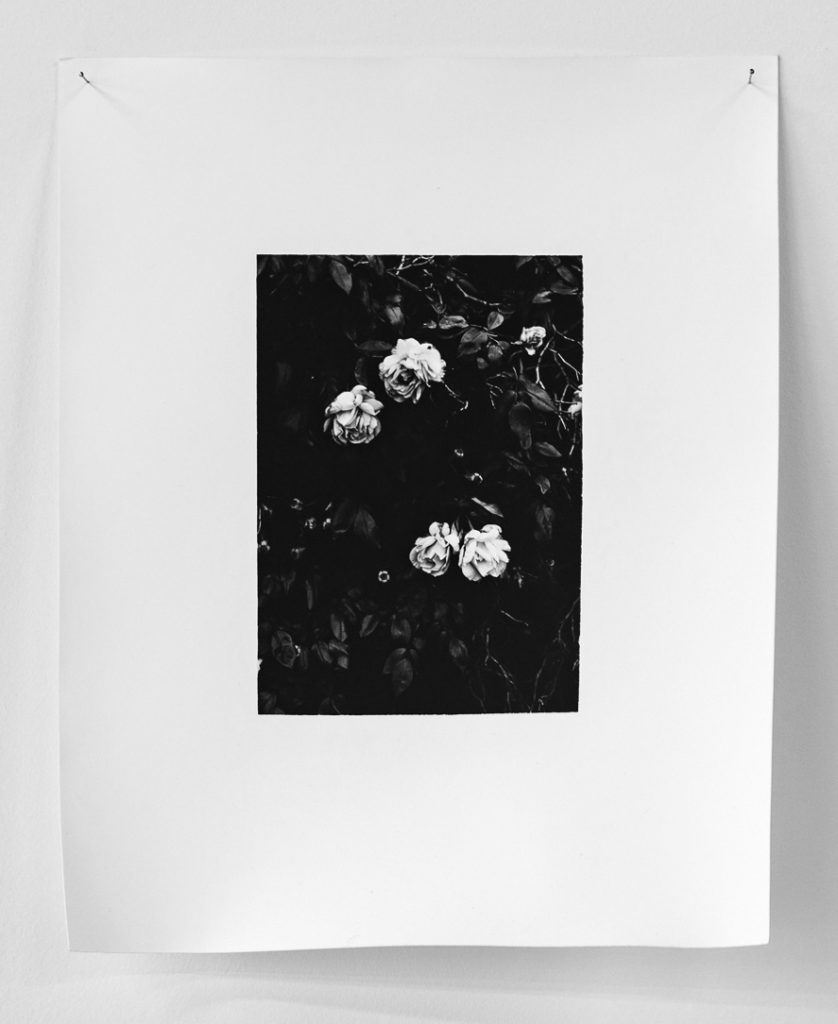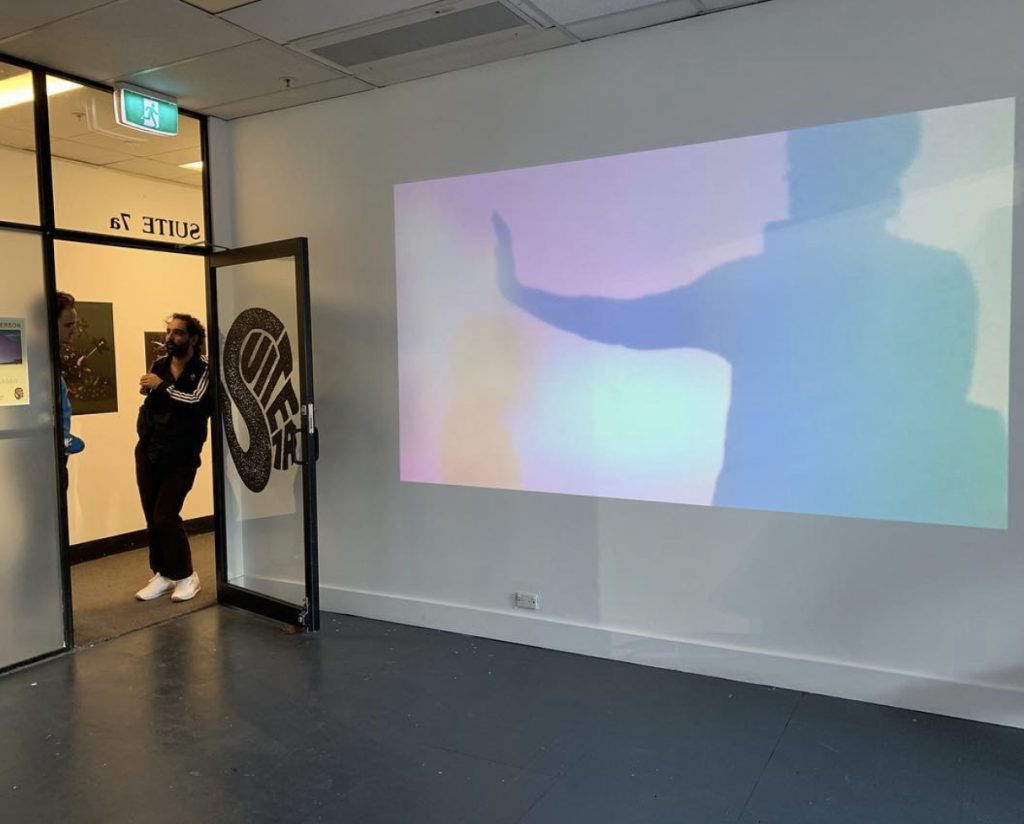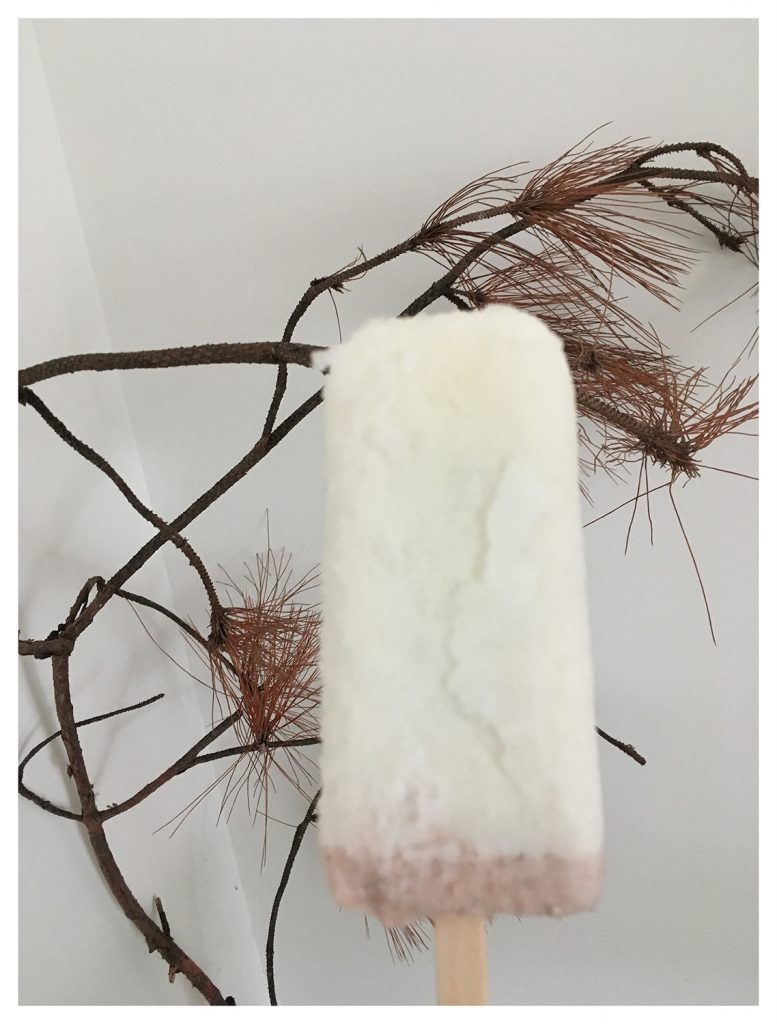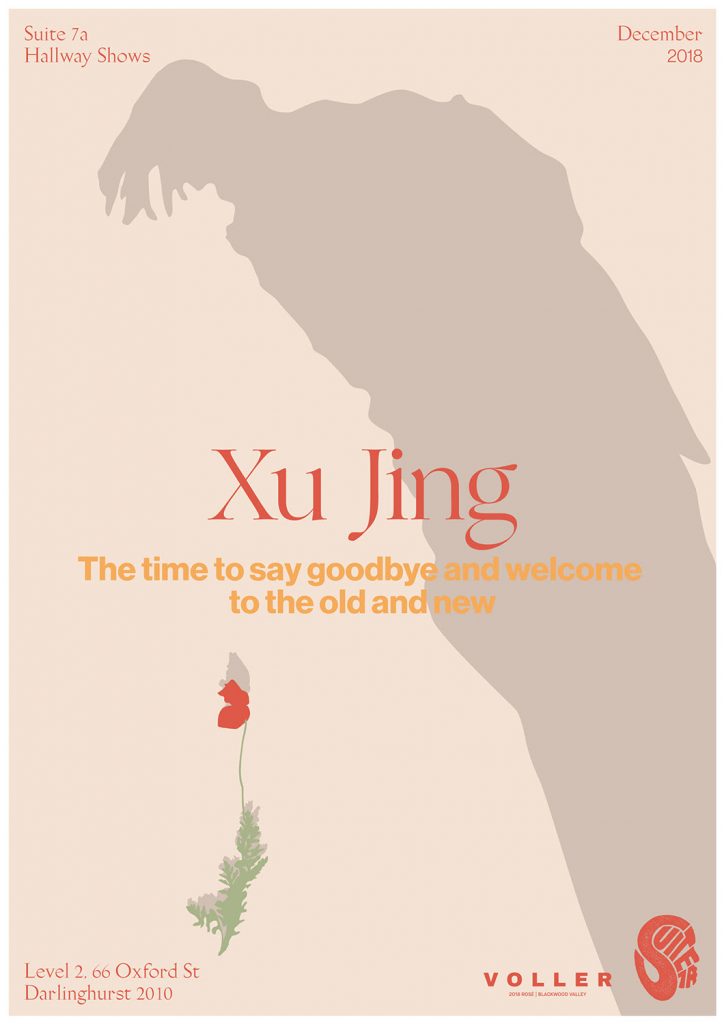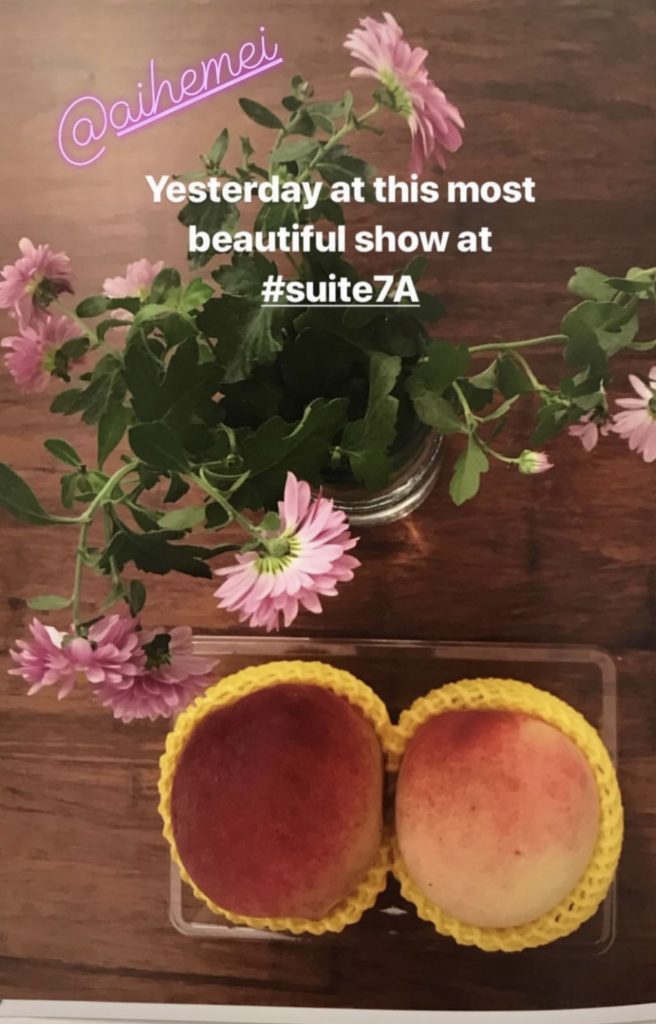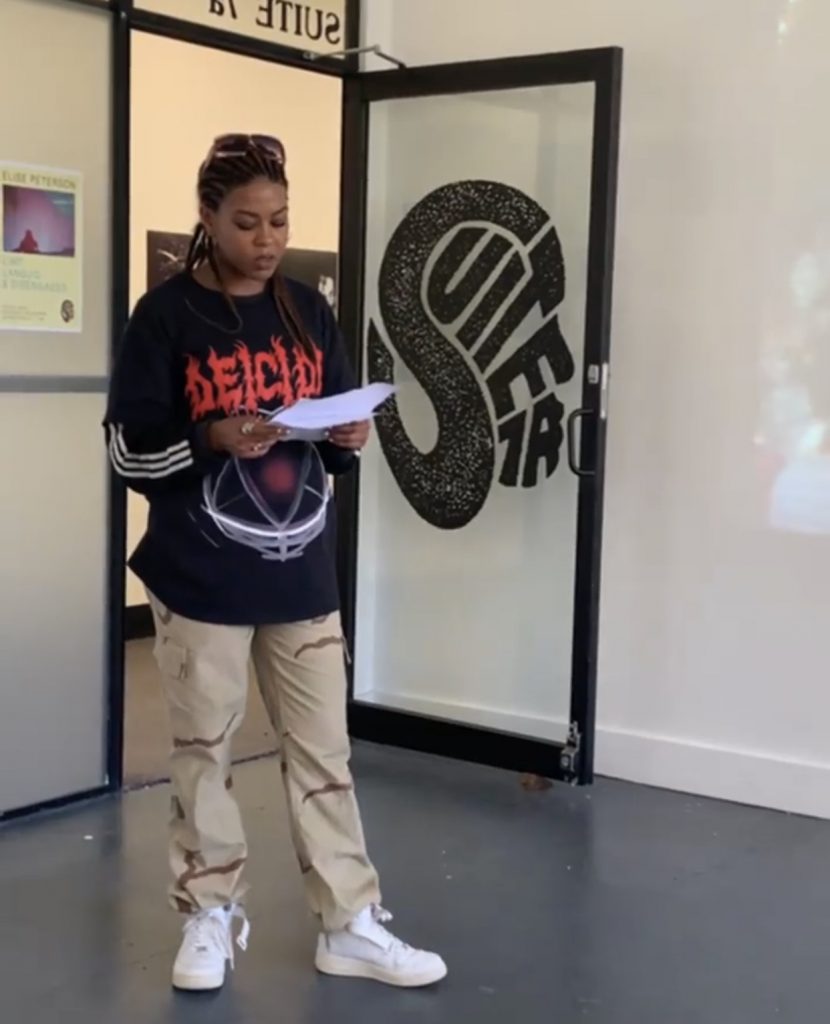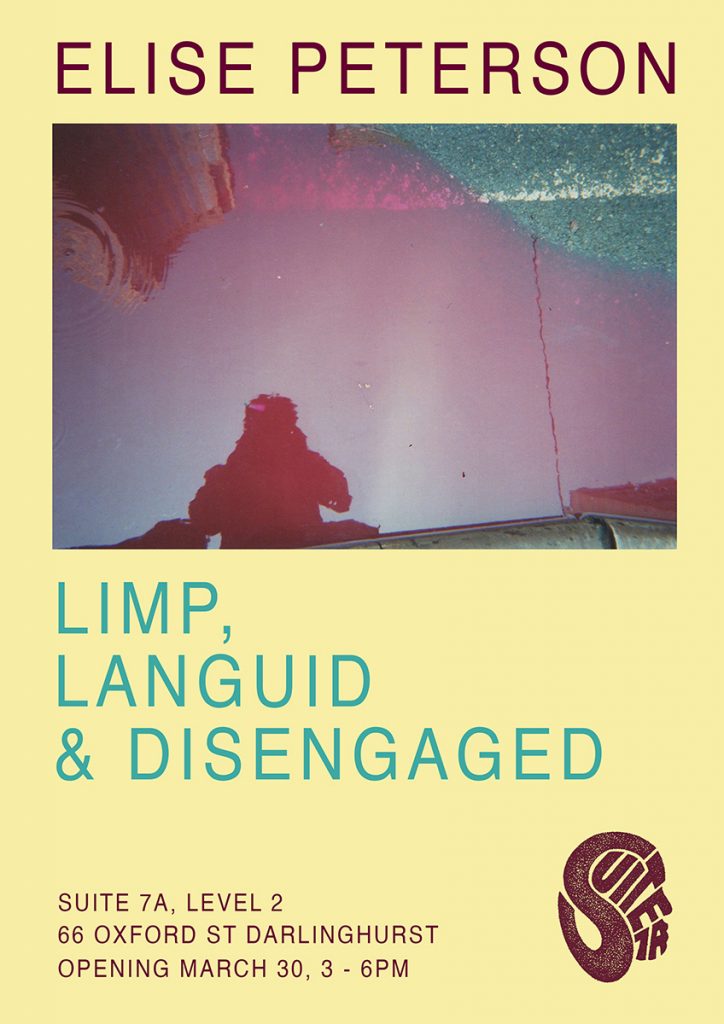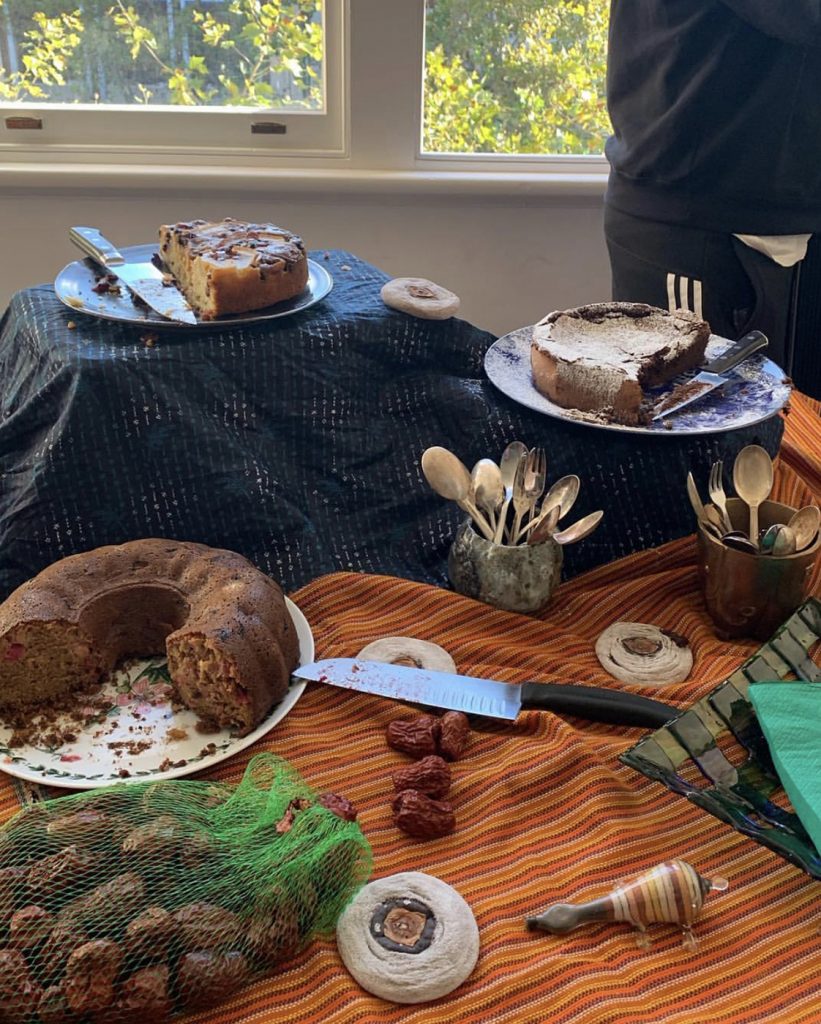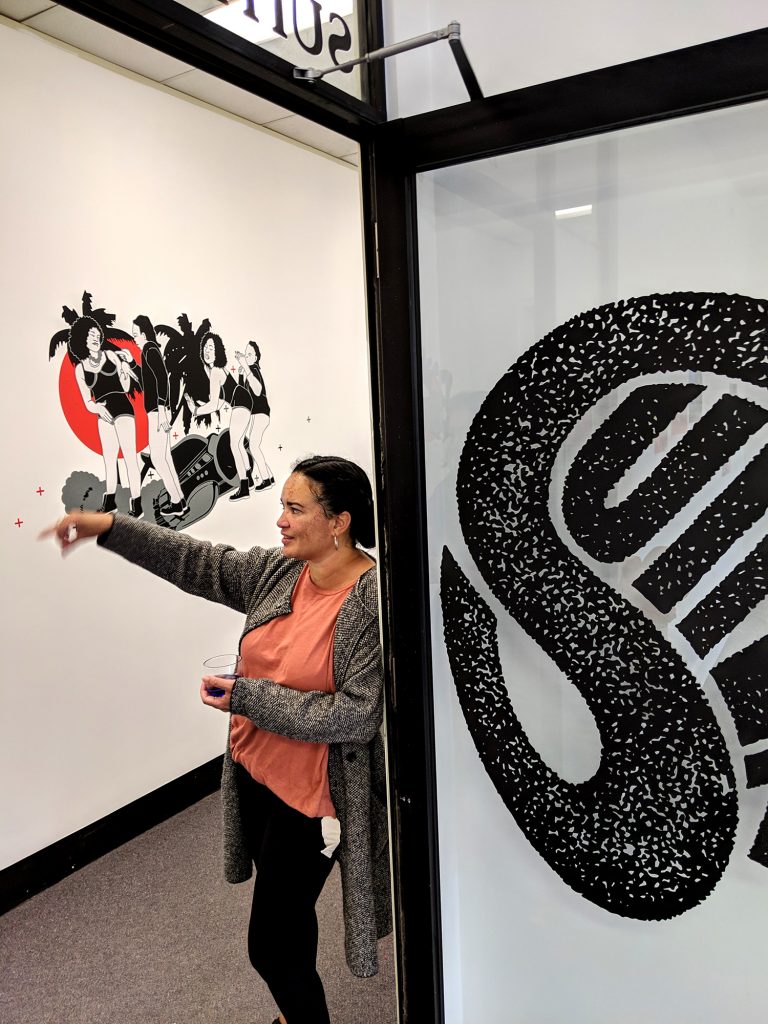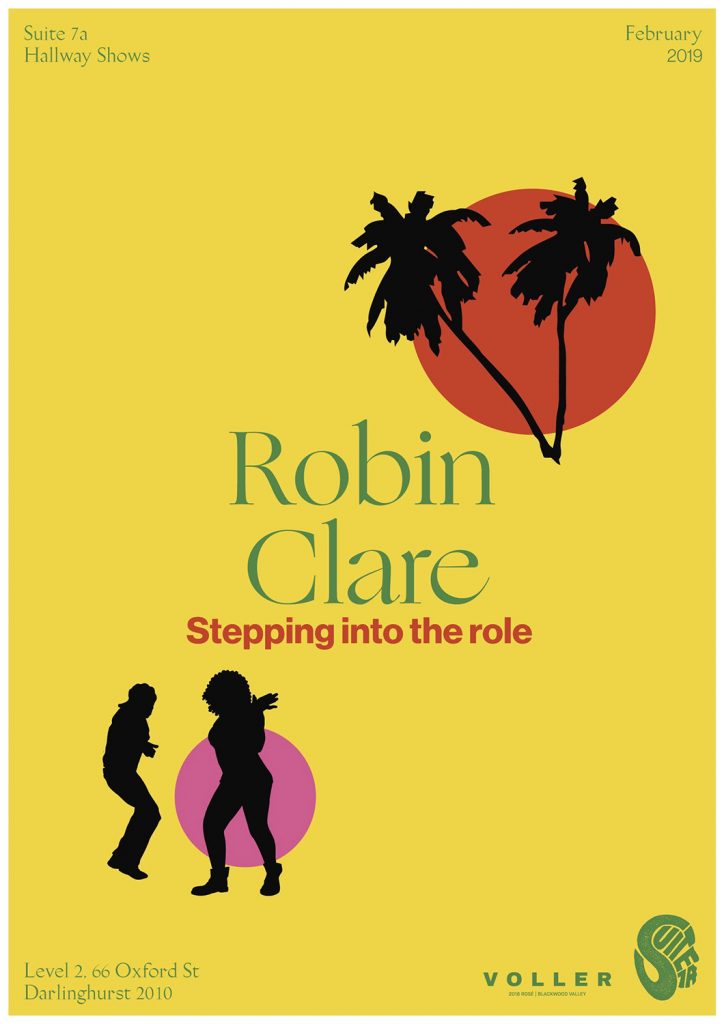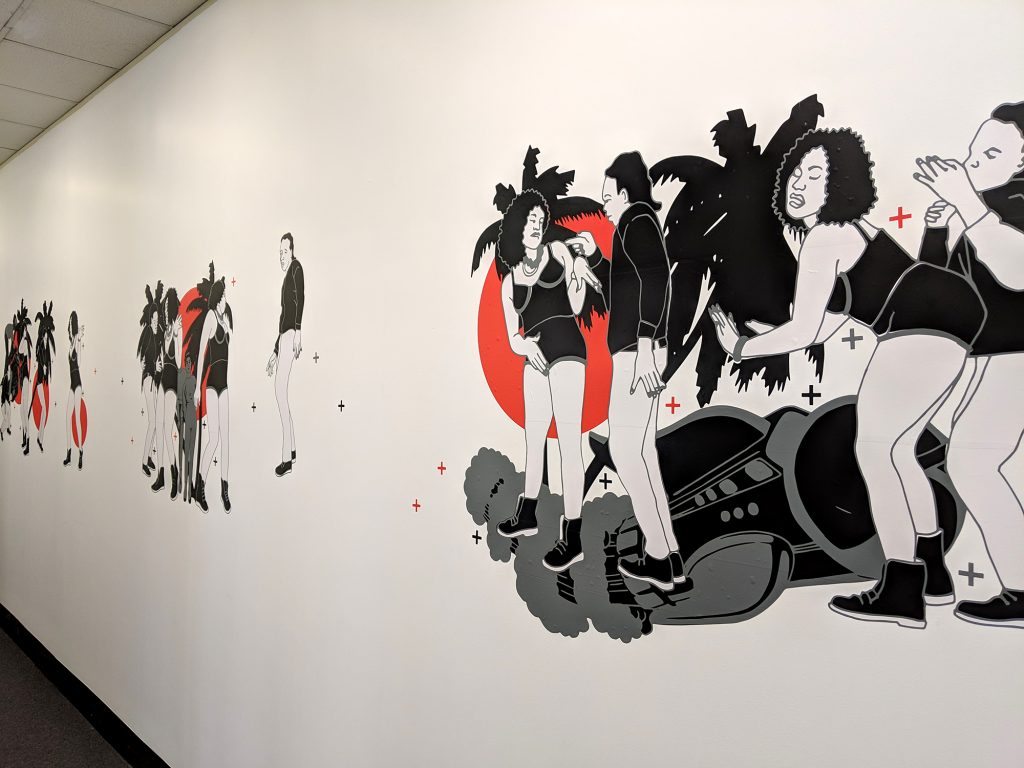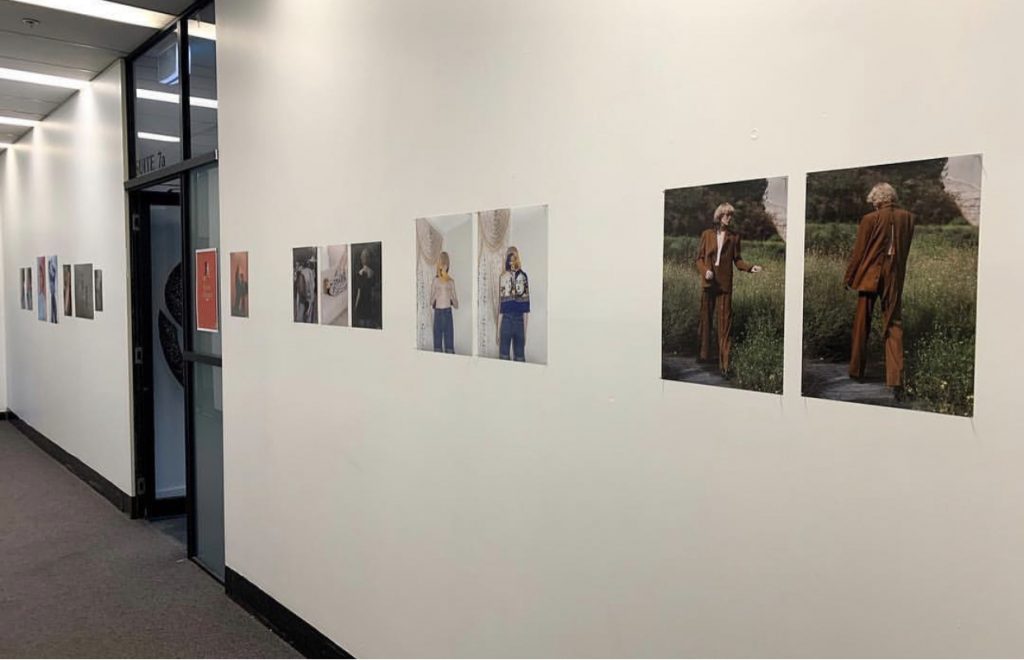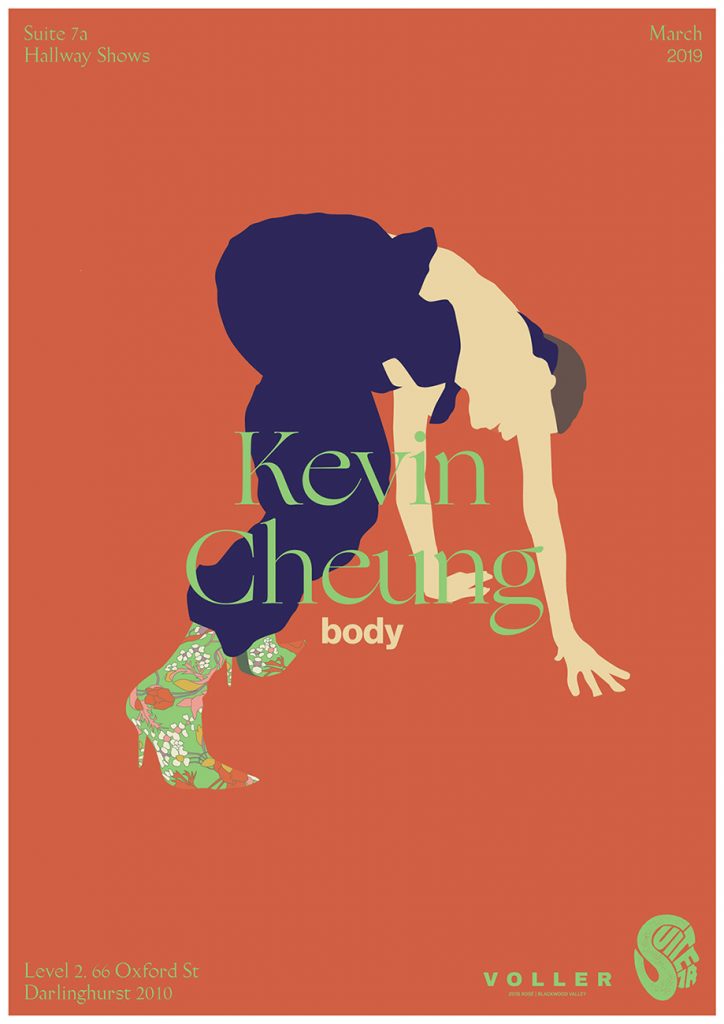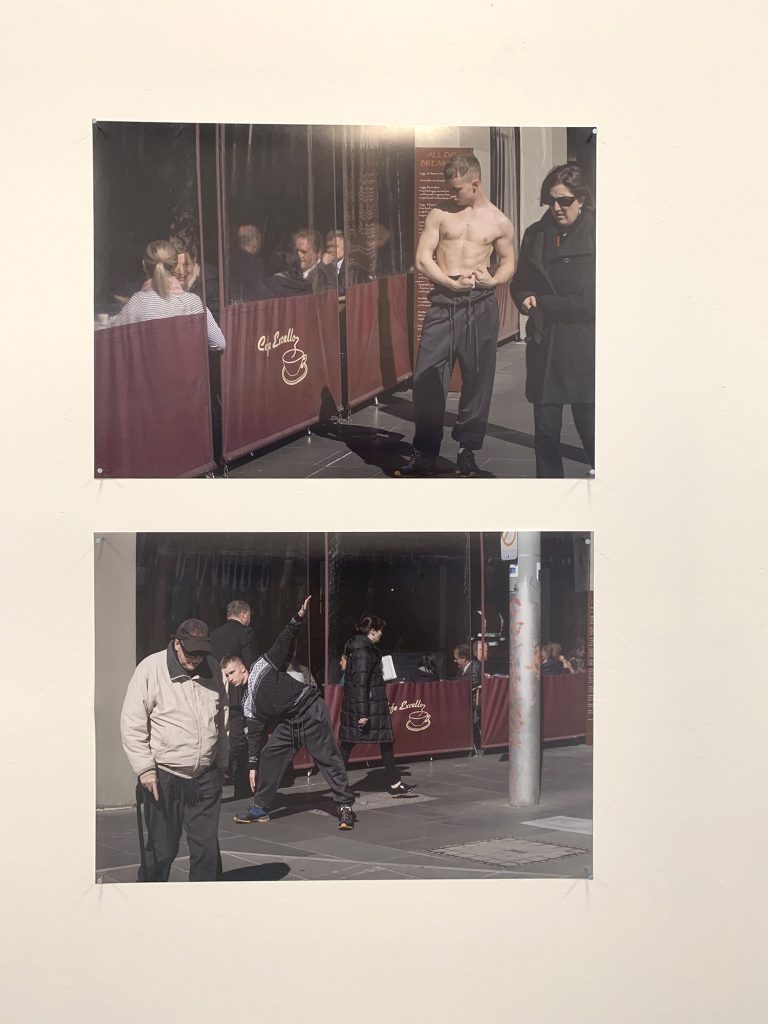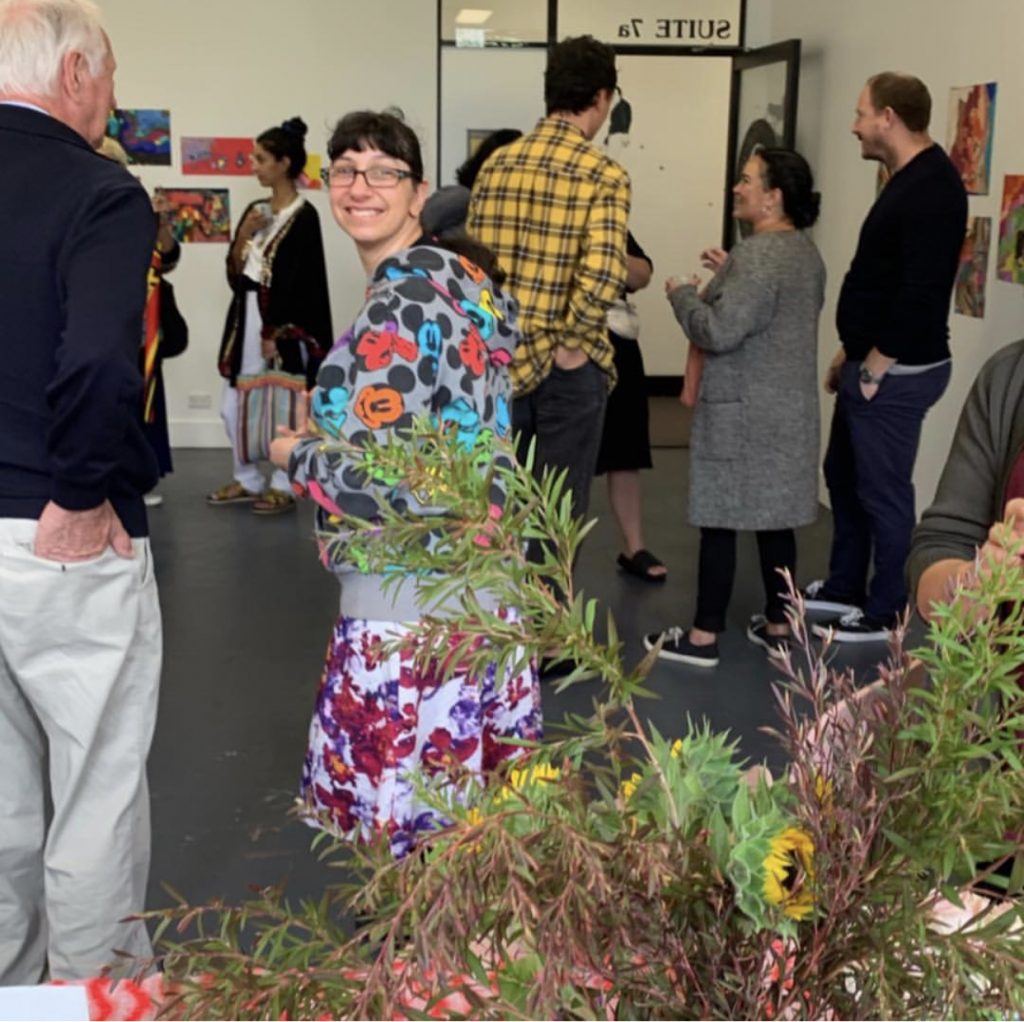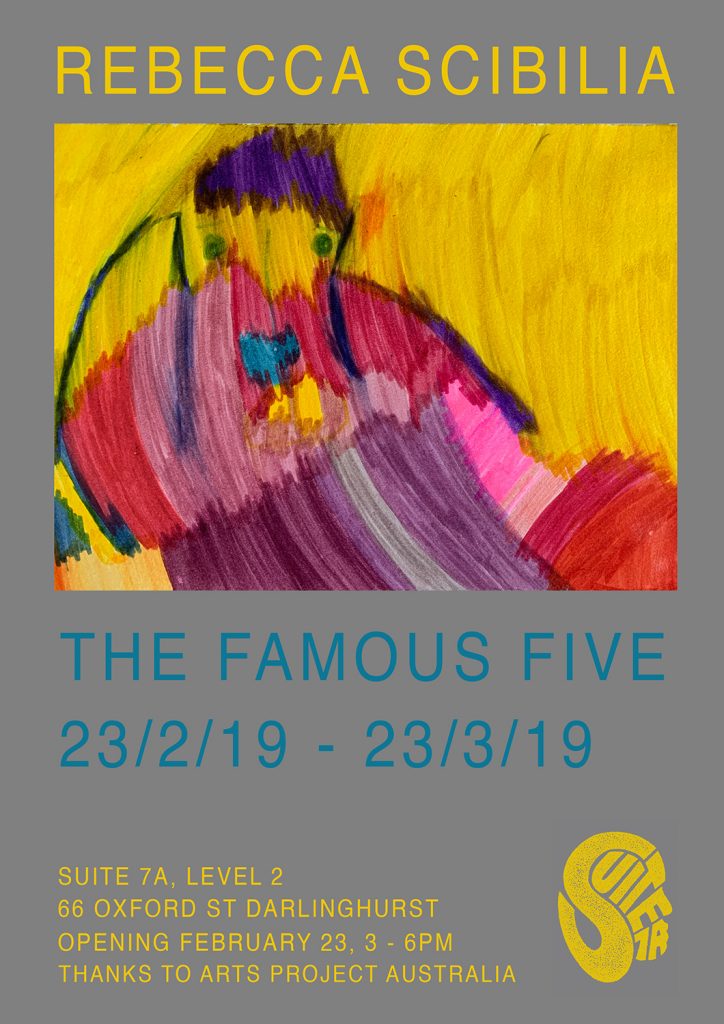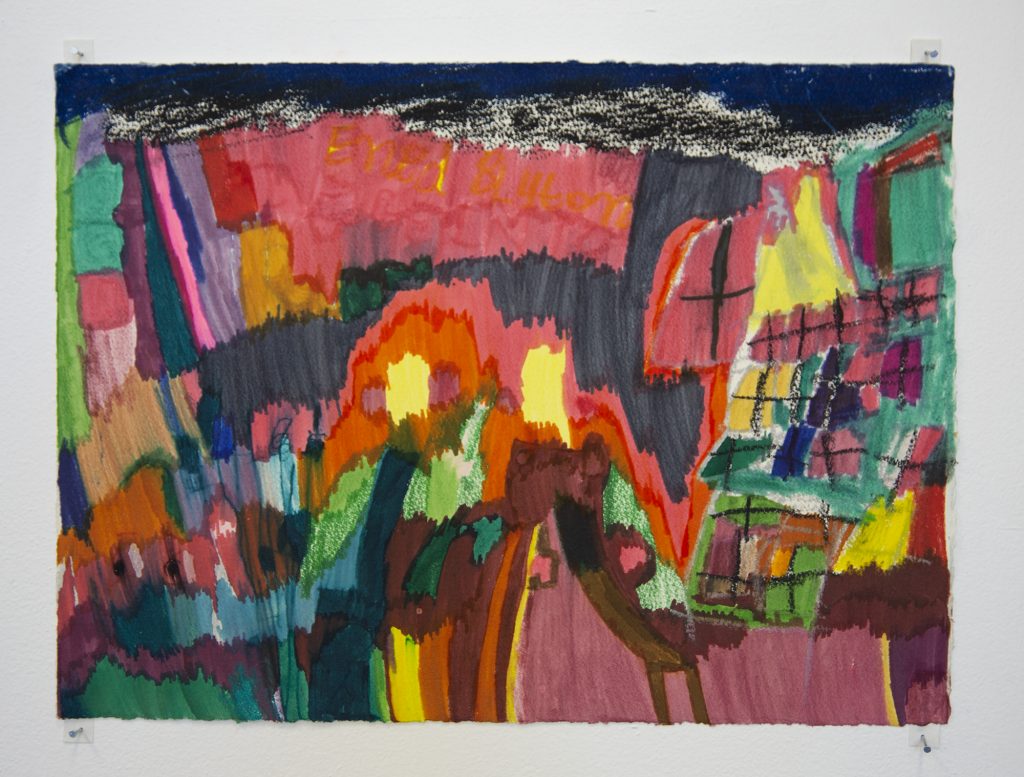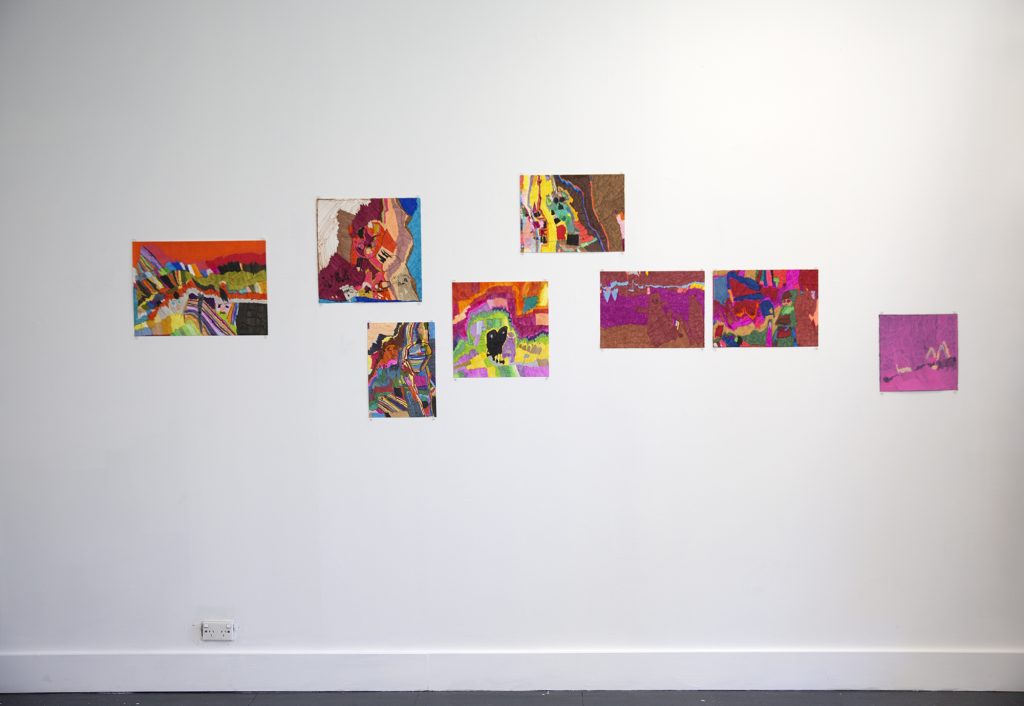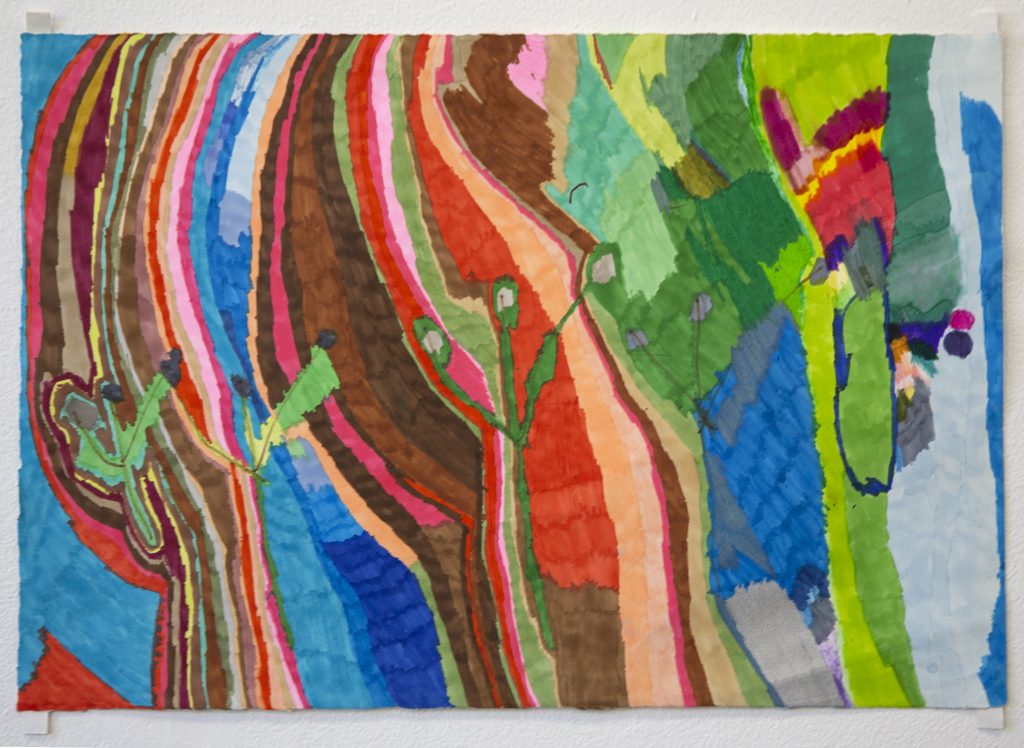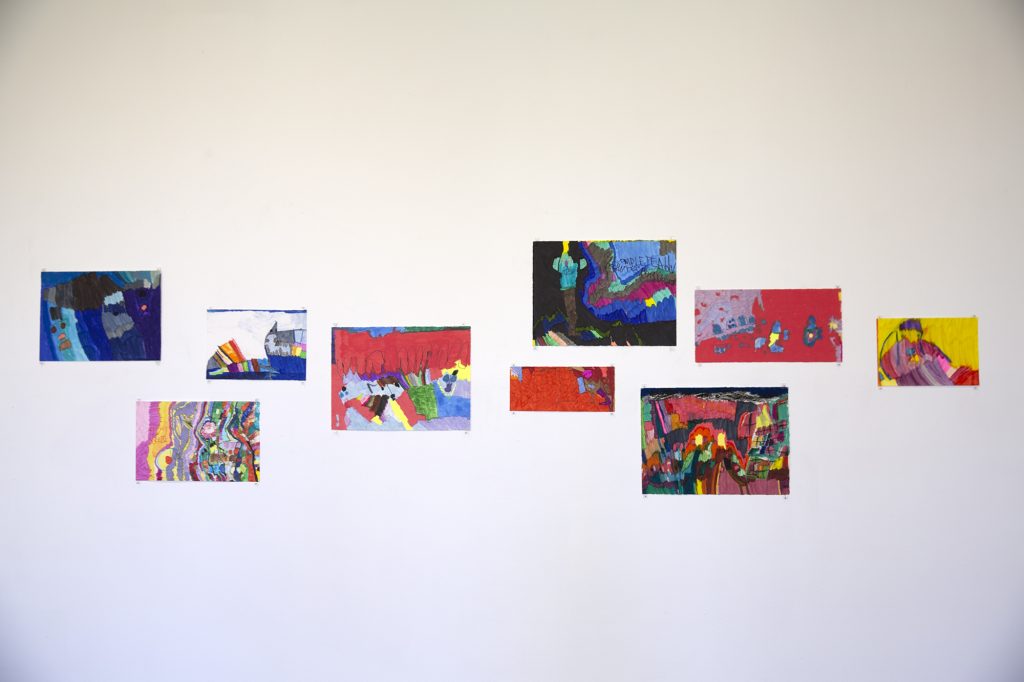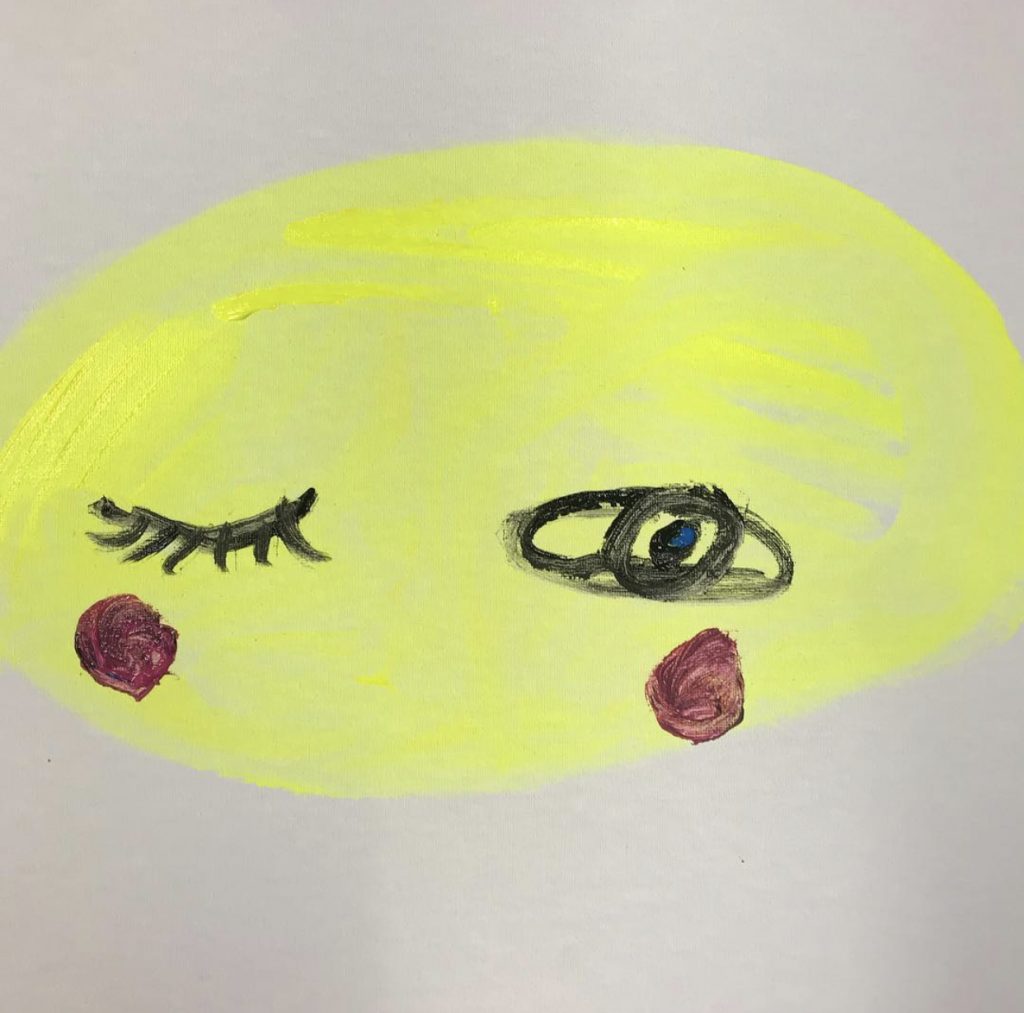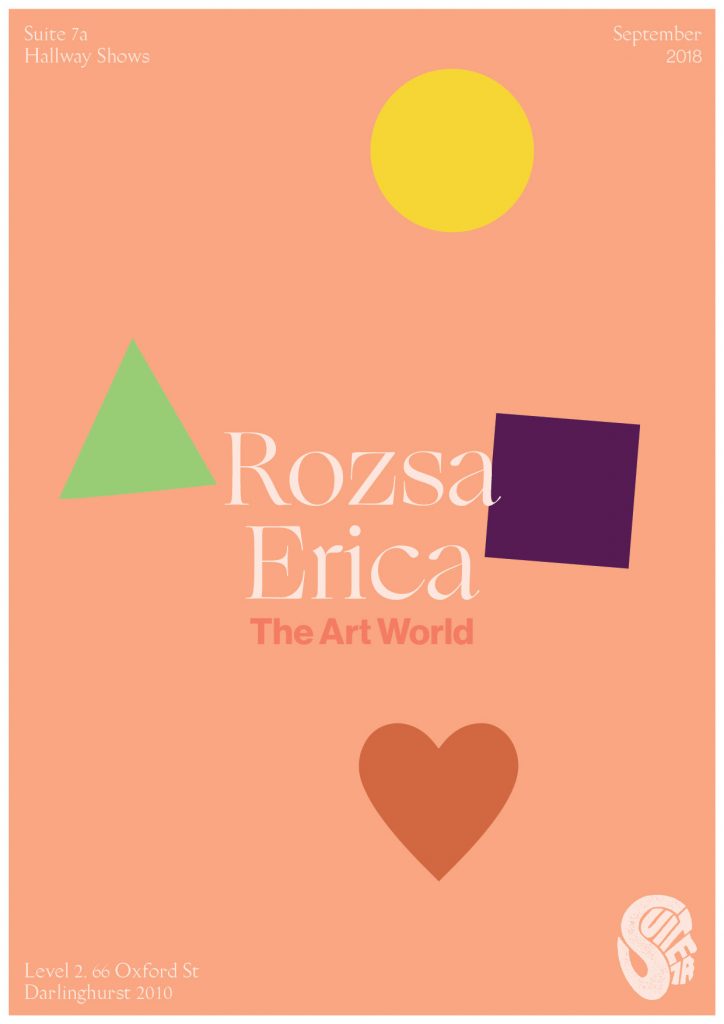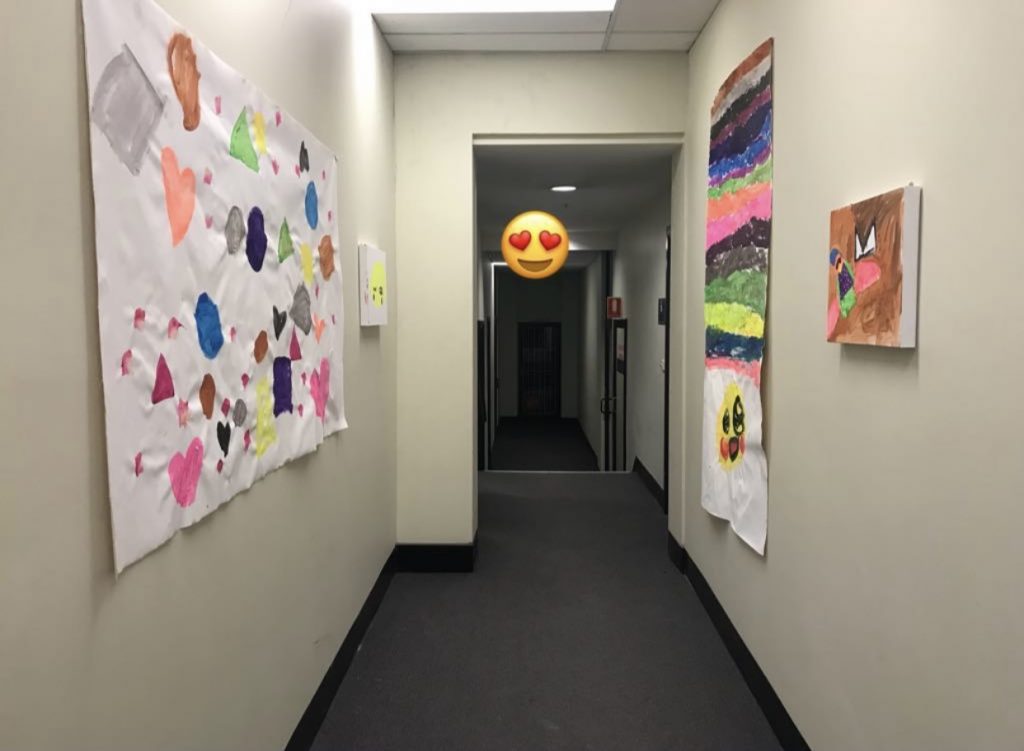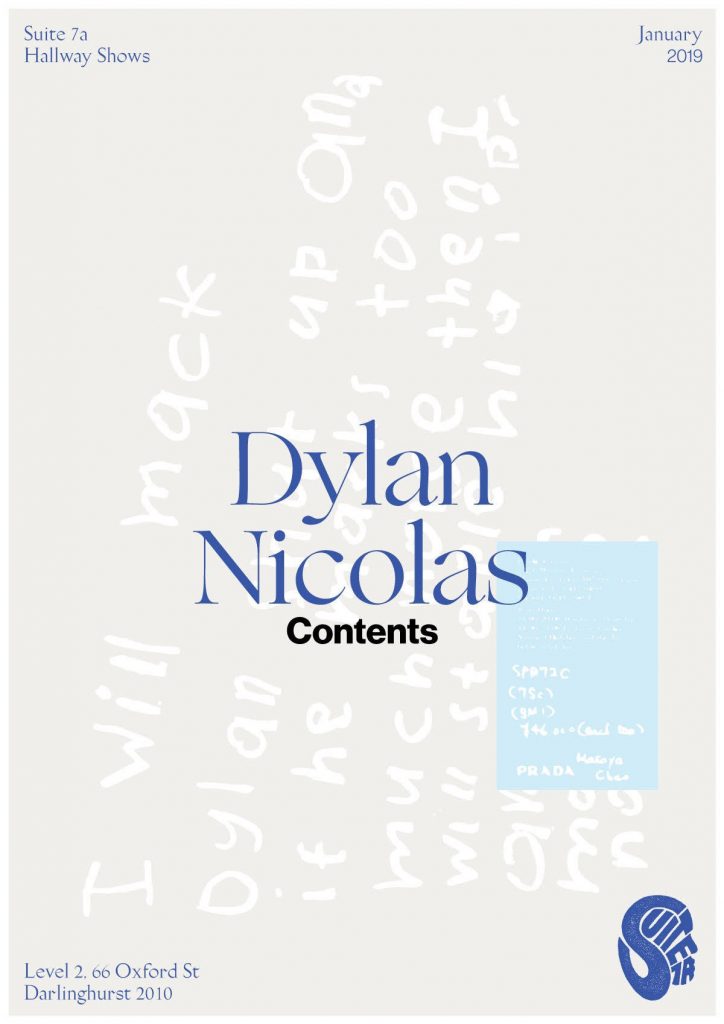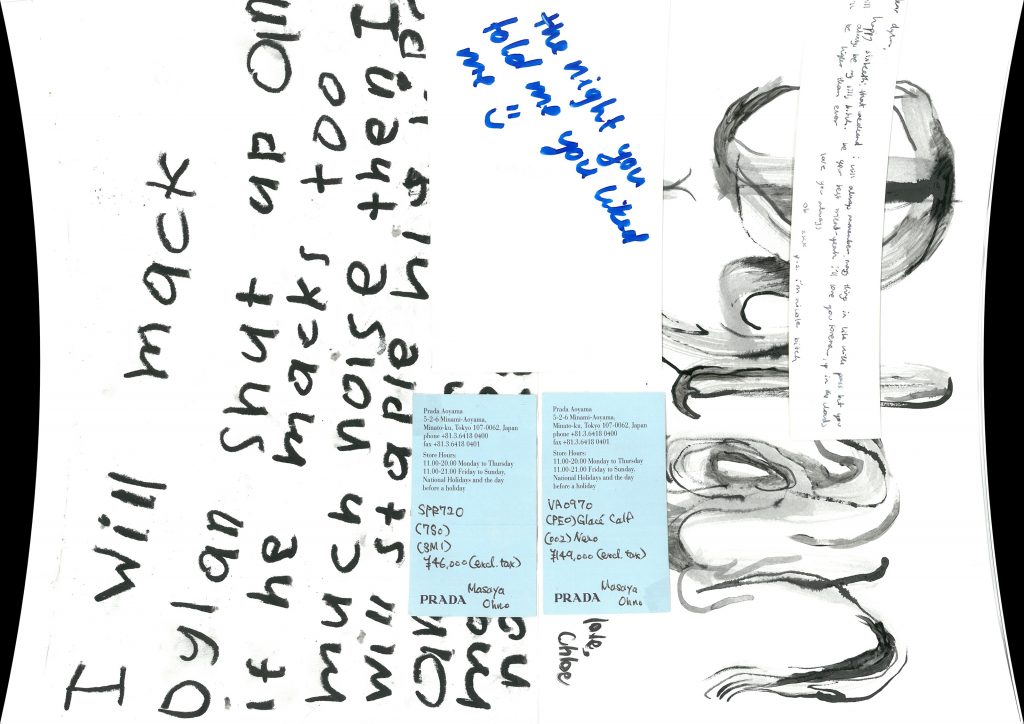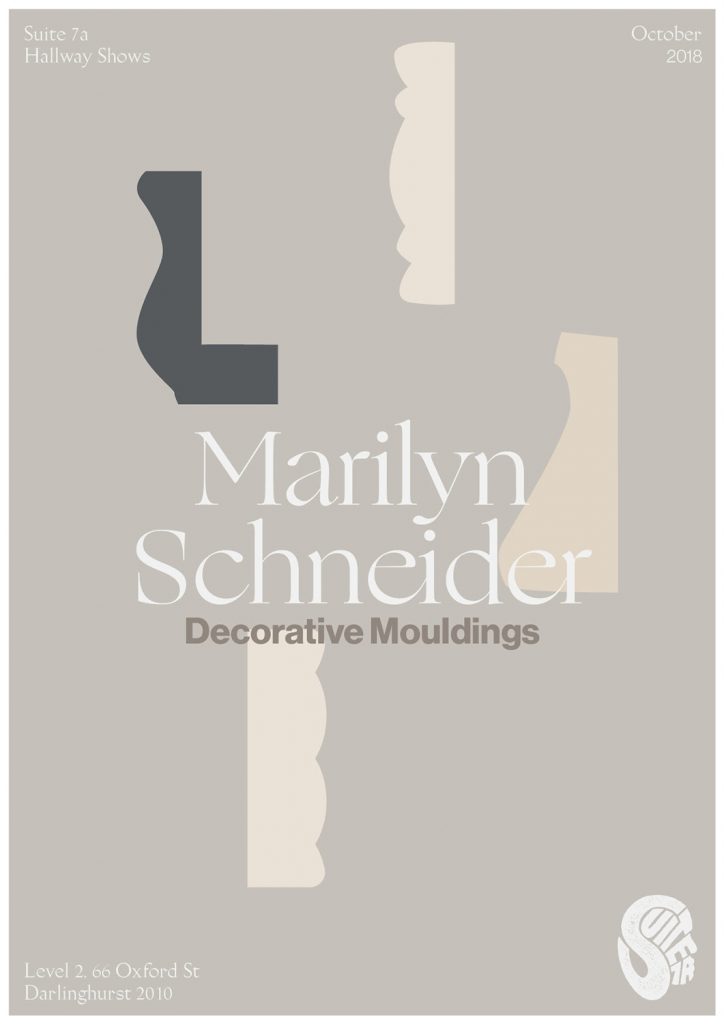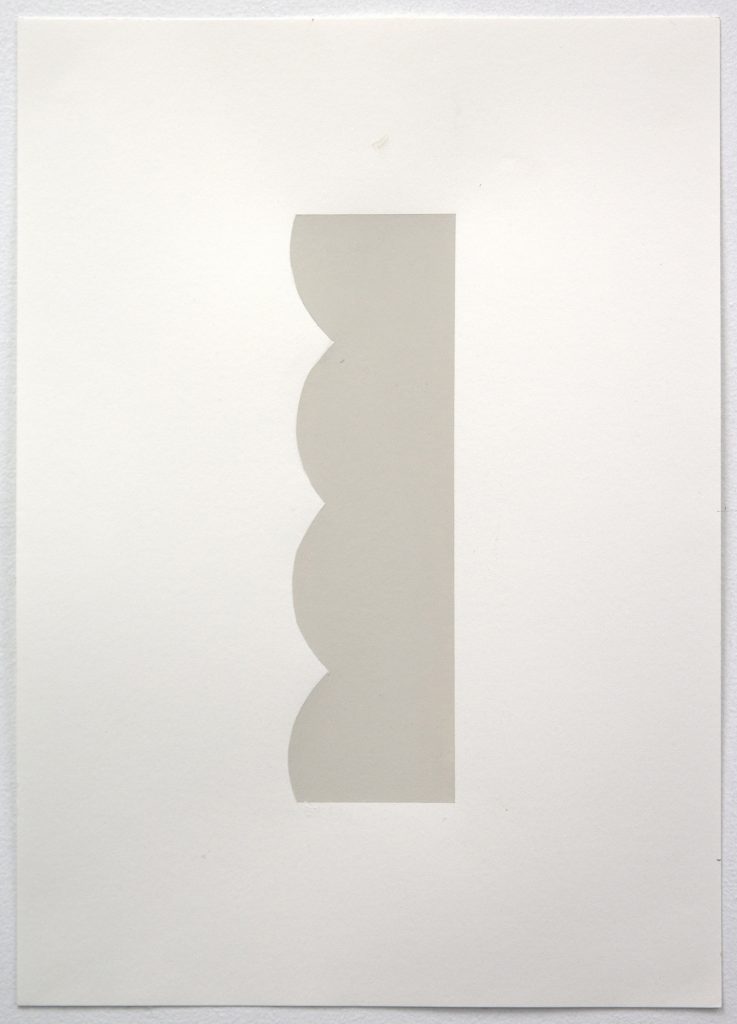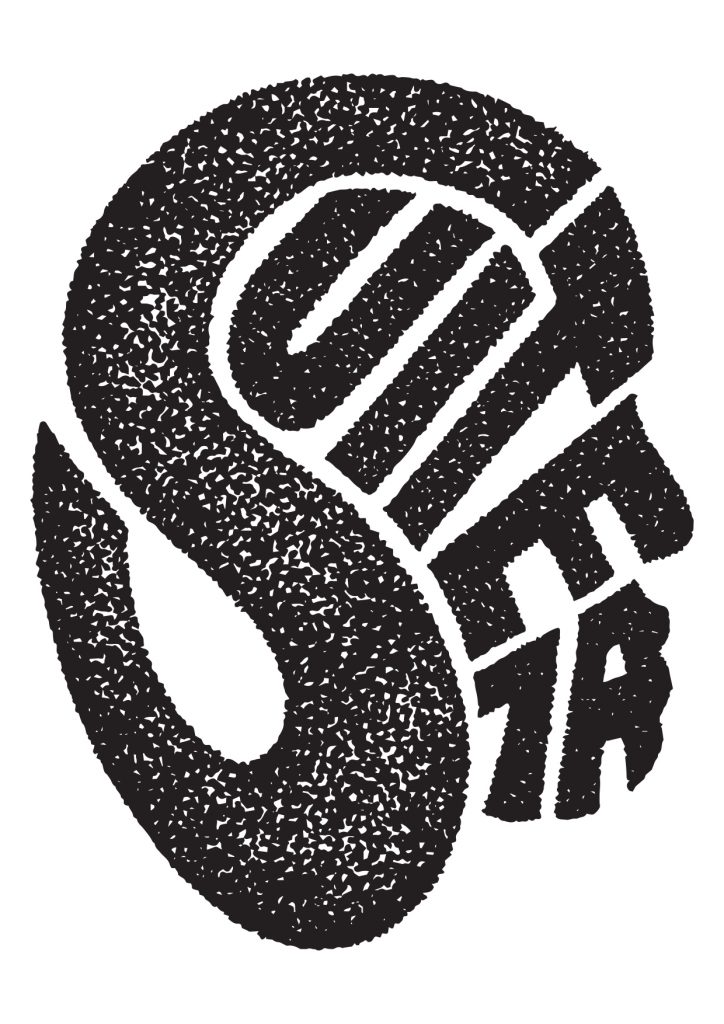
Suite 7a https://suite7a.bigcartel.com is an independent arts business. Born out of a City of Sydney studio residency and frustration with the industry. The first projects to come out of working in the space were organised by Rafaela Pandolfini with Ainslie Templeton; Session Vessels held off-site at Airspace Projects in 2018, followed by An Unintended Consequence (of labour) at The Downing Centre window boxes.
Exhibitions were also organised in the physical Suite 7a premises at 66 Oxford St Darlinghurst Sydney. In 2018 and 2019 there was a series of exhibitions in the hallway of the building including solo presentations by Rozsa Erica, Marilyn Schneider, Dylan Nicols, Robin Clare and Kevin Cheung, as well as 2 shows in the studio space by Rebecca Scibilia and Elise Peterson.
Suite 7a
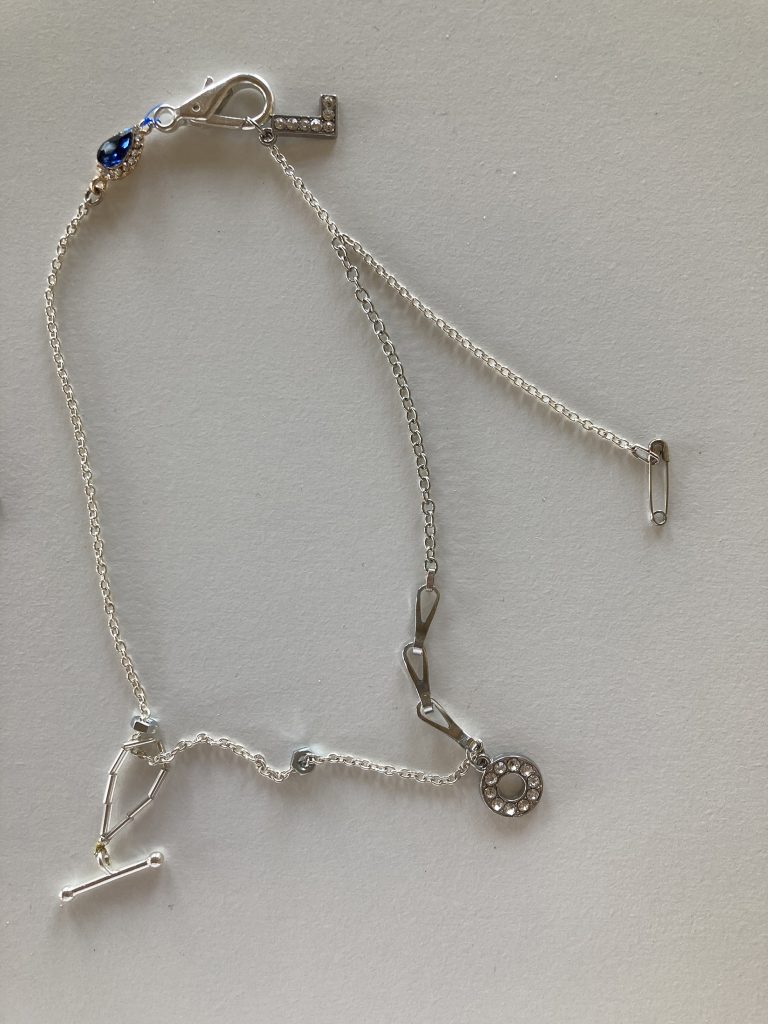
Conversation Debris Facility & Clementine Edwards
Hi Clem,
It was really lovely to have some time on the phone recently, while you were managing some logistics and admin of travel. I hope that your journey was enjoyable and you're having a good time on the other side.
I thought to get some questions rolling for this brief interview for Suite7a, and your jewelry/works which you're presenting with them, hence this email chain.
We've had ongoing conversations about the complex, contradictory, and pleasurable place that jewellery can inhabit, and its often awkward relationship with other modes of practice and discourse. I think that we're still somewhat invested in it, though unsure of if that investment is mutual? I'll spin off some thoughts about your work specifically, but also what kinds of itchy questions persist.
Firstly, i've been chewing over the interrelated notions of 'decoration' and 'de-core', that the decorate, embellish, excessorise is to complicate (evacuate?) the 'core' of something/one. how do you think that your practice approaches this (false) binary between the exterior and interior?
Hi dear Debbie - hooo this question!
The idea that accessorising can be or is a complication is one thing and that it evacuates is another within it, I think. Evacuation is uni-directional. It brings to mind whiteness' evacuated core (whiteness, as in a contextualised sort of 'de-racialisation' in relation to the mass culture that it finds itself in/presiding over)... and I instantly think of accessorising as the decorative pursuit, and Javed da Costa's 'I'm just so tired of being white!' sticker/action on the appropriative P.A.M. exhibit at the NGV in 2014. Contemporary decoration's hollowness in this sense is important to feel-know. But what is more filled with, well, anything (promise?) is this proposition that decoration is a complication. I want to walk in that open field. Complication can hold anything it needs to; it's an abundant proposition. And tbh, jewellery as a discipline and pursuit could too if it weren't hemmed in to its own 20th century self-built outhouse. Or maybe I'm being harsh - and definitely parochial. The plain truth is that jewellery leads me to art and art is the most complicated thing one can be busy with, because it too is an abundant proposition, in what it can do/think/enact/envision/etc. Following this interior/exterior binary, jewellery was my gateway into art as a practice, but art as practice can be without corner or edge. Once released inside that complex world, I can marinate in the delightful accessorising lavishness that is jewellery. In its craft, in its faith to those who engage with it, in its play. Its sweet accessibility allows many in.
I know that you have an ongoing investigation into 'material kinship', and the ways in which relationality and objects are intertwined with an unfolding subjectivity. Could you please briefly introduce your thinking on this and apply some of that thinking to these works for Suite7a?
Essentially, material kinship wants to think material beyond extraction, and kin and kinmaking beyond bloodlines. These might be obvious provocations to some, but for me they've been a kind of a guiding star into radicalisation - social, theoretical, political, practical, whatever. So with the Suite7a works, I've worked with materials that I've found, bought, gathered from south Rotterdam (my home) that might live in different places on the supply-chain or that just enliven my relationship to the supply chain. It can be more than that though, like, jewellery is known for its value as a tradable item based on its composites. It's less speculative than art. But some things come into one's life and take up residence. I have that with jewellery, like many do - rings and necklaces as literal charms or talismans, signifiers of this or that, heirlooms and treasures. What's one's relationship to their entry into or departure from one's life, and the time spent together? What stories do we tell about them (these stories have adaptive consequences, as Robin Wall Kimmerer says), and what does that do to the ways in which we relate to the world around us? How does the relationship persist... how does the very material persist and in what forms? Material kinship, which is polyvocal (there's a Reader coming), started with this thinking and opened outwards as it stepped into language and art.
Email #1.
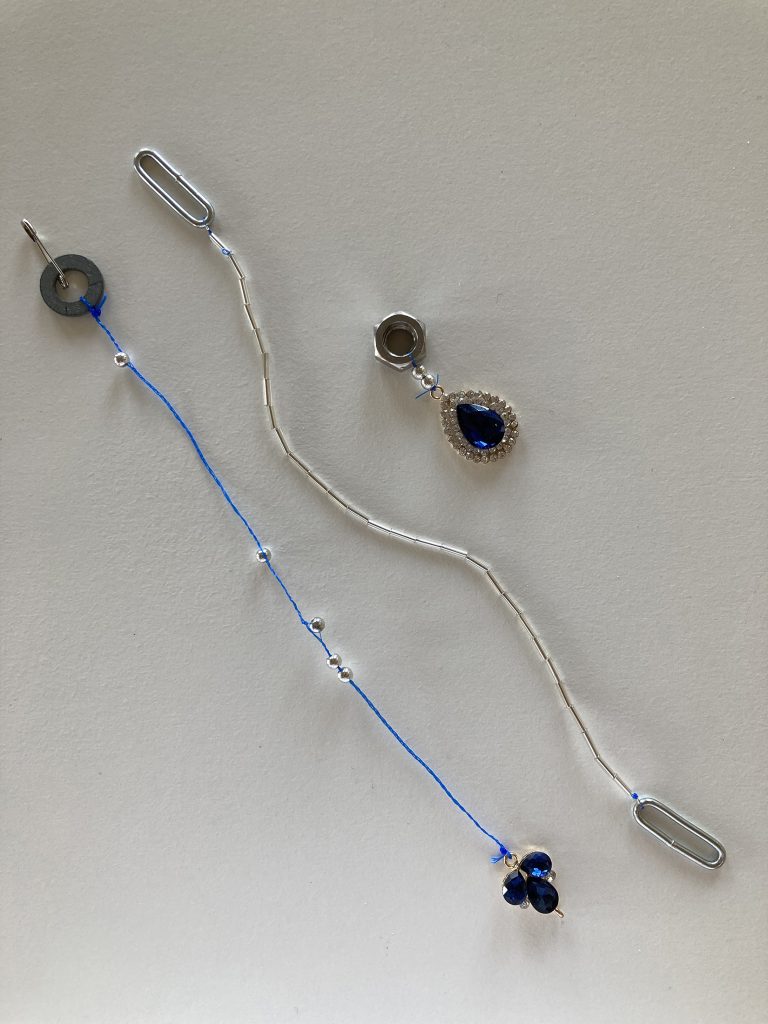
Within your framework of Material Kinship, I particularly resonate with the 'enliven my relationship to the supply chain' element of thinking, and how it engages with global capitalism and extraction, but avoids a kind of moralistic approach to consumption. The approach of anti-capitalism, but adoring the pleasures of material consumption is fraught (and maybe that's why it's appealing?). I wonder how you see this supply chain being enacted within the process of your works being sold through Suite7a, and then having another iteration of kinship with a new owner/custodian/friend.
The supply chain does a little loop-de-loop with my decision to make and sell work via Suite7a, I think (like, looping the materials into different circulation cycles?). Or perhaps I'm simply adding a new link in the chain... Albeit a humble link. The materials wouldn't have converged as works had I not been invited by Rafaella. We decided that I would keep them in the Netherlands and send them wherever to cut the back-and-forth. I suppose that's a slimming of the chain. Nonetheless the chain does extend; it certainly doesn't pretend to refute capitalism... When someone wears my jewellery, I make a point of suggesting/pointing out that they are free to customise it however works for them - to add to it, adjust it or break it down - to increase the likelihood that they'll develop an active sort of relationship with it.
I'd also love to hear your thoughts on the overlap and friction between the precarious and precious within Material Kinship. How value is ascribed, attached to bodies, worn and exchanged can be held in more fixed or transitional states. The neo-liberal parasite has rendered most labour unstable, our climate system is precarious, and already collapsing, so what use (if any) is there in preciousness?There are so many ways of understanding preciousness. I choose to take it here as dear or beloved, something too important to be treated carelessly. This approach has the potential to (re)frame one's relationship with the world, to remind us to go tenderly. And so it folds in quite nicely with the precarious, and how life teeter-totters.
Hoarding is hinted at when one takes preciousness to mean 'of great price, cost or value', whereas there's generosity in the preciousness I describe above. It promotes care(taking), even if the preciousness isn't shared or circulated.
The climate system is in a precarious state due to some-human activities across recent history. These extractive activities have taken the world and all within it as resource and property from which a certain kind of wealth may be accrued. Extractive cultural and social practices are fed by this, breeding scarcity. These activities treat life, land and waterways as fixed or, if not fixed then not important. Fixed ≠precarious. Not important ≠precious... Perhaps precarious is an acute version of interdependence? Fixed/stable ≠interdependent (precarious).
On a more whimsical note, jewellery is expected, ideally, to be precious in both senses that I describe, and fixed. Shock resistant and holding its monetary value, as well as, potentially, accruing a sort of dear and beloved status if 'used' well. An engagement ring will probably only be precious in both senses if the relationship continues in a positive/enriching way across time. This is the peak 'use' of precious, I guess? In a capitalist sense... Dream-making.
What do you think about this question, Deb?
Email #2.
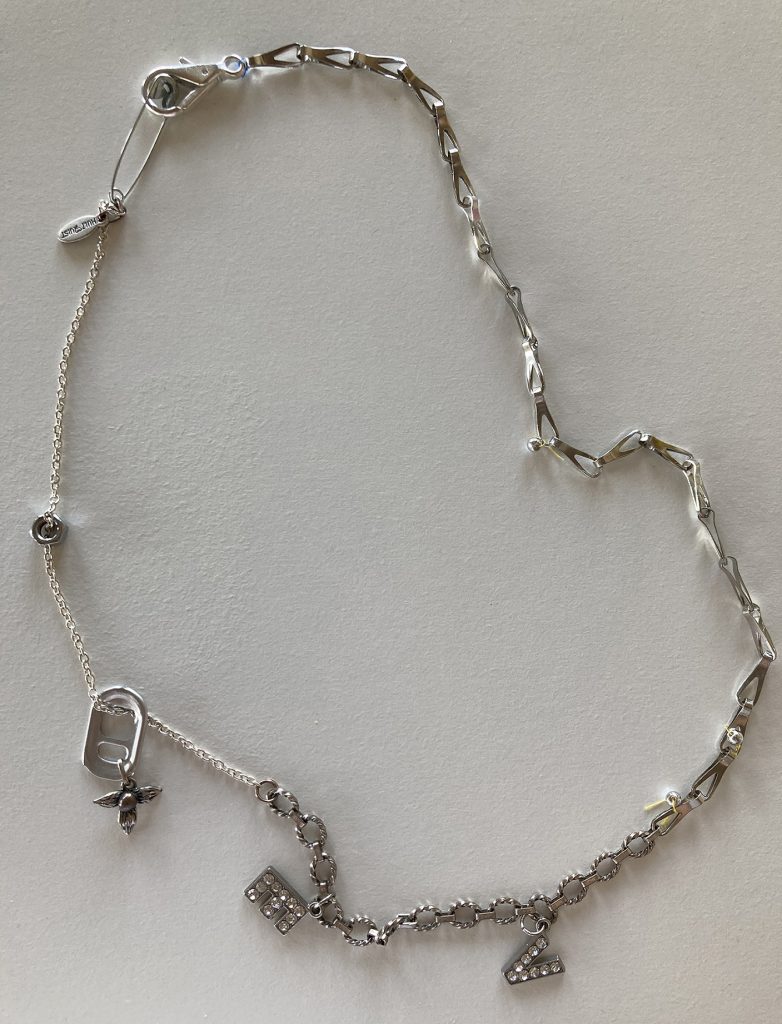
Some of the agenda of the Facility is to amplify the noise between these states of precariousness and preciousness. How we interdependently ascribe value is an important process to wrest away from capitalism. Preciousness has an intimacy which is useful in terms of kinship making. This makes me aware of the use of jewellery and the body as a display mechanism of relationships and cultural forms. What I appreciate about jewellery is that it's as much haptic as it could be optic; the weight and sensation on the body enacts a kind of reminder. There is a history of the antique and heirloom, which I think we both relish in entangling. Would you have any thoughts on the temporality of these works? Furthering their supply chains into some speculation into their future lives, with the possible mutation from its owner?
This, yes!: "How we interdependently ascribe value is an important process to wrest away from capitalism." Imagine haptic value systems, or ascribing a type of value via touch... towards haptic experience as currency in and of itself.
I find it hard to think backwards in time unless it's a humble amount (since invasion) or a drastic amount (fossilised life). Part of the work of material kinship is trying to do this; it takes me a lot of effort. In 2020 I did a performance into it, thinking with the rats that rule the city that live in and eat the insulation below my house, thinking with their calcified bodies after I poison them, how they co-mingle into the Rotterdam sand dredged from the North Sea... Dreaming forward into the heirloom or supply-chain is even harder, and I'd need a few days to conjure it. It's safe to presume their futures will be buried, charred, submerged with the rest of us.
I'm also aware of your linguistic powers, and that you have a rich writing and editing practice which sits alongside and informs your making. Would you like to unpack some of the pleasures and frustrations with jewelry as a wearable vernacular language?
In answer to this question, this conversation with you has been so immensely fruitful on this question. Exchange with friends is a rich site for play around such pleasures and frustrations. A simple vernacular frustration that winds a path away from your question might be the lacklustre mode of titling shows and works within the jewellery world... I've done it myself. Jewellery puns and nature references are the fuel here.
Email #3.
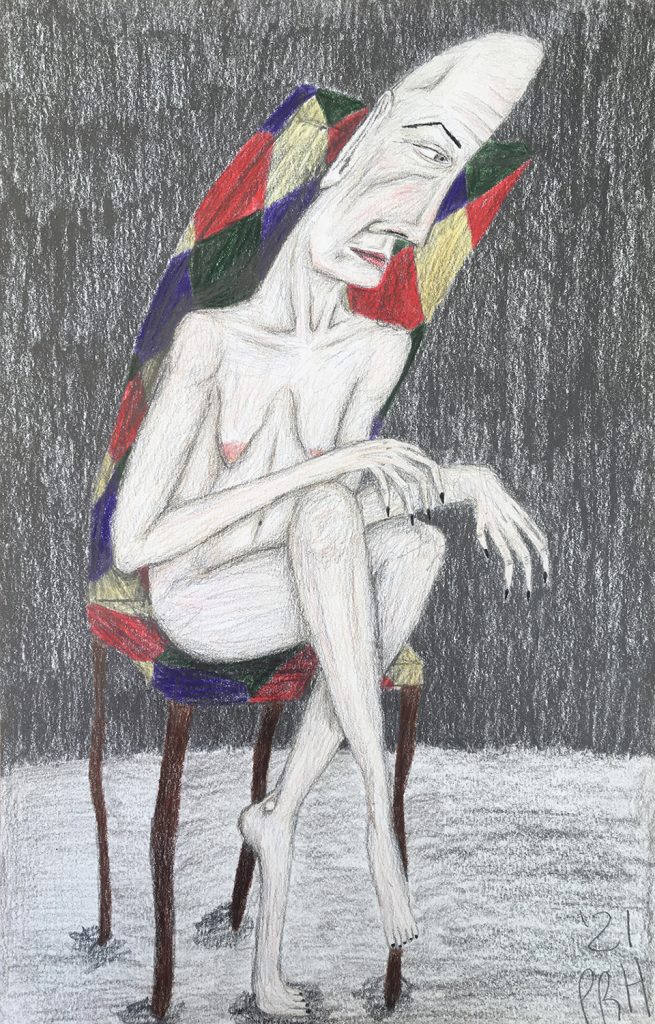
Rabu, 2021
29.5cm high x 19cm wide
Graphite and coloured on paper
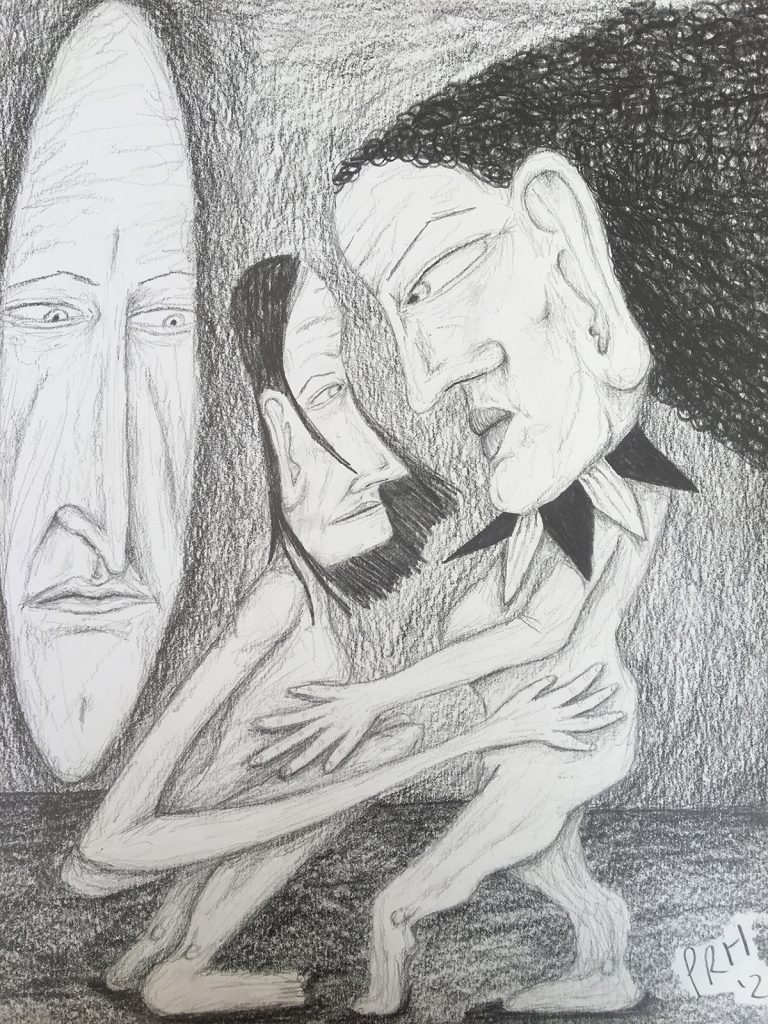
Cicily Von Trumpet, 2021
42cm high x 29.7cm wide
Graphite on paper
Hana Pera Aoke: Kia ora koutou Priscilla. First of all I wanted to check in and see how you are and send all my love to you. It is such a strange and stressful time of uncertainty and it is a huge relief for me that we are both in places in Aotearoa that have not got cases of the delta variant. We both moved back to Aotearoa around the same time and because of the virus, both of us have come back to our home towns, family and smaller art communities, so I feel like it is interesting to reflect on how these changes in your life have perhaps shaped your output? I'd also then like to know if you could speak broadly to whether this time of uncertainty and ongoing crises has in any way affected what you have been drawing?
Priscilla Rose Howe: Kia Ora Hana, sending my love to you also angel. I am doing okay and have been spending my time in lockdown drawing and reading books, in the sun if I can and lots of river walks. What a great question! I was living in Melbourne and had to move back quite abruptly as I lost my work there and had the realisation that I couldn't realistically/financially stay there. Once I had moved out of the quarantine hotel up in Auckland down to Christchurch with my fam it felt like I was back at square one in a sense? Like I had no job, no flat etc. I started to really focus on my mental health and make an effort to look after myself. I decided to watch things that brought me happiness/nostalgia - like re-watching Round the Twist, things like that. So yeah... I guess consuming content that sparked my creativity and focusing on myself and what was important to me really shaped what I was interested in drawing.
H: For me, I find your drawings a nice mediation on the idea of creating or building new worlds, ontologies and ways of being. They often make me think of David Lynch's work, particularly the most recent Twin Peaks series, because your work can be unsettling, other times humorous, cheeky, familiar or childlike. When you start a drawing what are you thinking about? Is it an intuitive, meditative kind of process? There's definitely a queering or discombobulated sense of time and narrative, but could you speak to these inner worlds you have created?
P: Oh yes I love David Lynch's work haha, he was pivotal actually. The first film of his I saw was 'Eraserhead' with my parents when I was a teenager. I loved the otherworldliness of the film ESPECIALLY the lady in the radiator. It's funny, I was just thinking about the scene in the second Twin Peaks series *SPOILER ALERT* where Josie dies and she's on the door knob. Second series is definitely my least favourite but I love this scene. That and the lady in the radiator illustrate a supernatural unfolding in the domestic setting so well. Lynch does this so perfectly which I reckon comes from his own experiences.
My practice is veeeery intuitive, I never plan my drawings they create themselves however sometimes I'll be like "ooh I want a log cabin vibe" or "I want an Akaroa vibe or a West Coast vibe" haha. In terms of these worlds, I guess a lot of it comes from my obsession with phenomenology and the absurd. I'm super fascinated in the unknown realms and supernatural shimmers that can sometimes appear in the everyday domestic setting My ghost experiences shape my work and the worlds I create in a subconscious way I believe. They tell me that there are realms that exist outside of this physical one.
I am also inspired by theatrics and new ways of being. I was at an elf/mystical themed party at the beginning of the year and there was a person there who introduced me to the concept of a "shirty" where you wear a dress shirt with no pants. I loved that because I often find myself doing that to my figures. New ways of dressing/performing that are outside of "societal/expectations". I view my drawings as a way to explore other modes of being that exist outside of the capitalist, hetero-normative and straight and narrow system. I want my body to bend backwards and wind and twist.Interview
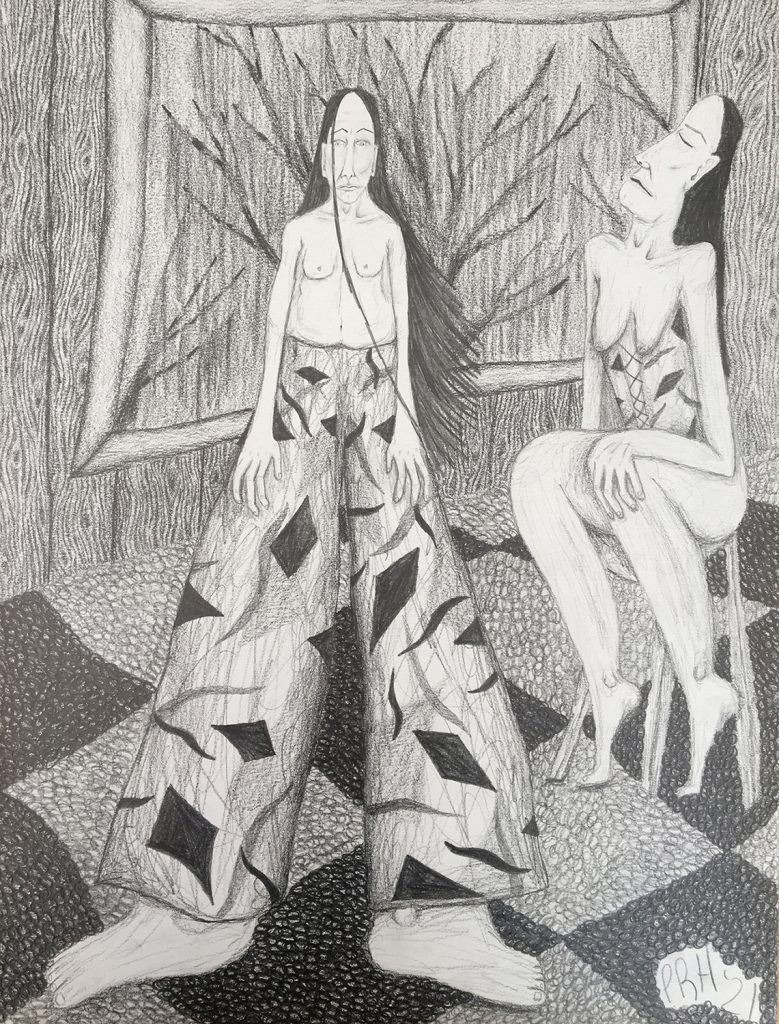
Swarvy, 2021
42cm high x 29.7cm wide
Graphite on paper
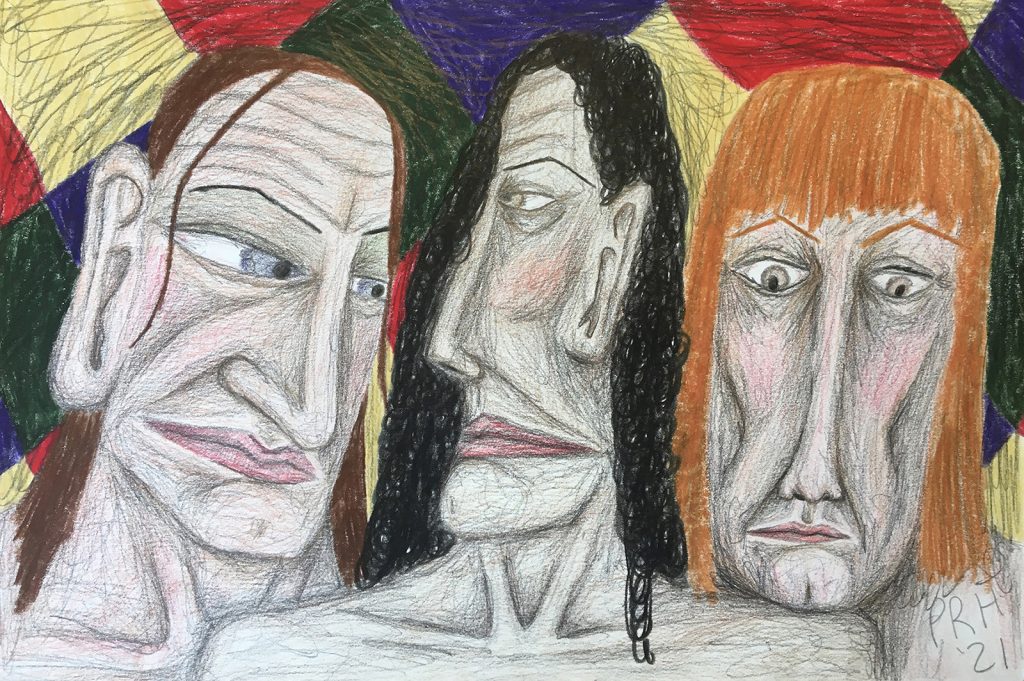
Juggle Master, 2021
20cm high x 29.5cm wide
Graphite and colour pencil on paper
H: There's a feeling of childlike wonder to the idea of being 'shirty' or of bending your body backwards and winding and twisting it around. For instance children are so much more intuitive to making art than what happens when you go through an institution, like art or design school and you have to always explain your decisions. I'm always amazed by how they see the world and their bodies. It's so fluid and inspiring. Would you say that you have been actively unlearning a more institutionalised way of making? How has living with a small human shaped the kind of work you are making?
P: Oh definitely childlike! And I really value childlike wonder and imagination as an adult. Living with a 4 year old has been so inspiring; she's a very imaginative kid and she just says things how it is! She can literally turn rocks outside into worlds with personalities and storylines. I find myself as an adult really trying to delve back into that childhood intuition and curiosity when I'm making art or even when I'm dancing/moving my body for sure. A practise that is really important to me is when I have time alone in my room to dance, I like to create big ugly movements especially and it feels very liberating; like I'm creating a space to be myself and exist outside of societal expectations.
H: There's so much joy in your work, and joy is something I feel is kind of lacking in a lot of artists' work, especially in Aotearoa. Do you think this intuitive way of making comes from a place of joy or of wanting to be in spaces that prioritise playfulness, fun and joy, especially given the state of the world?
P: Oh that's great! Joy is so important. I get so many varying responses like creepy, ugly, elaborate etc. Because I never plan out my drawings and they come from such an intuitive space they open up potential for so much interpretation which I love. Joy and playfulness is very important to me as an artist and motivates me to keep doing what I'm doing, so I guess yeah! It's a wanting to be in spaces that prioritise playfulness for sure.Interview
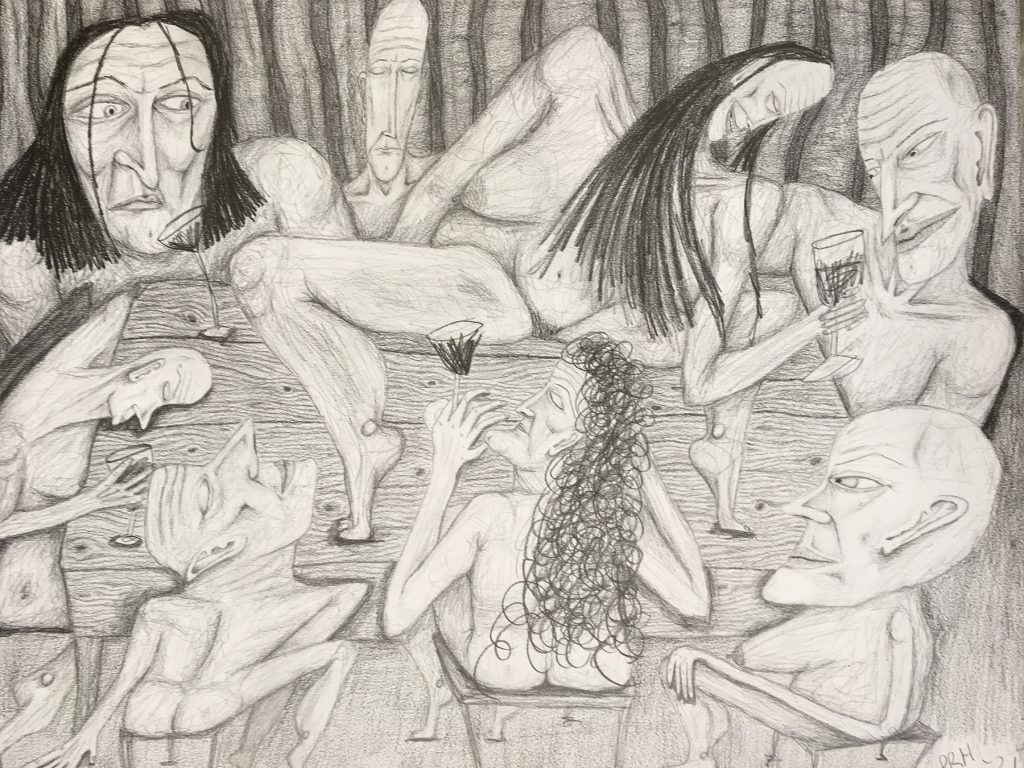
Splendour, 2021
50cm high x 60cm wide
Graphite on paper
H: Could you speak a little bit about the materials you have been using? I've noticed that your more recent works have drifted away from coloured pencil and more into monochromatic charcoal.
P: For sure. For this series of drawings I've been really enjoying playing with graphite as I can create a lot of richness and depth in the work. The shading and toning process is different and can take me a lot longer! During lockdown this has been really cathartic and expansive for me. A film that I love and inspires me greatly and especially for this series is "Night of the Hunter" a 1950's b&w film. It explores child fantasy, grief, loss and joy and the shadows and depth created through the monochromatic medium are stunning. I find with black and white there is a lack that I really like - there's more of a sense of the unknown.
H: Finally, what projects are you working on at the moment and what direction, if any, do you hope your work to head into?
P: At the moment I am working towards "Cruel Optimism" the New Artists show at Artspace! It's very exciting because I'll be working with artists whose practises I really admire and it gives me a great opportunity to expand my practise. After that I believe we will be doing the Te Tuhi billboard together ;). In terms of my direction, in all honesty I'm just going with my intuition and what feels right. I'm in the stage of my career where there will be a lot of trial and error and I'm open to learning and growing as much as possible! I want everything to be organic and feel natural.Interview
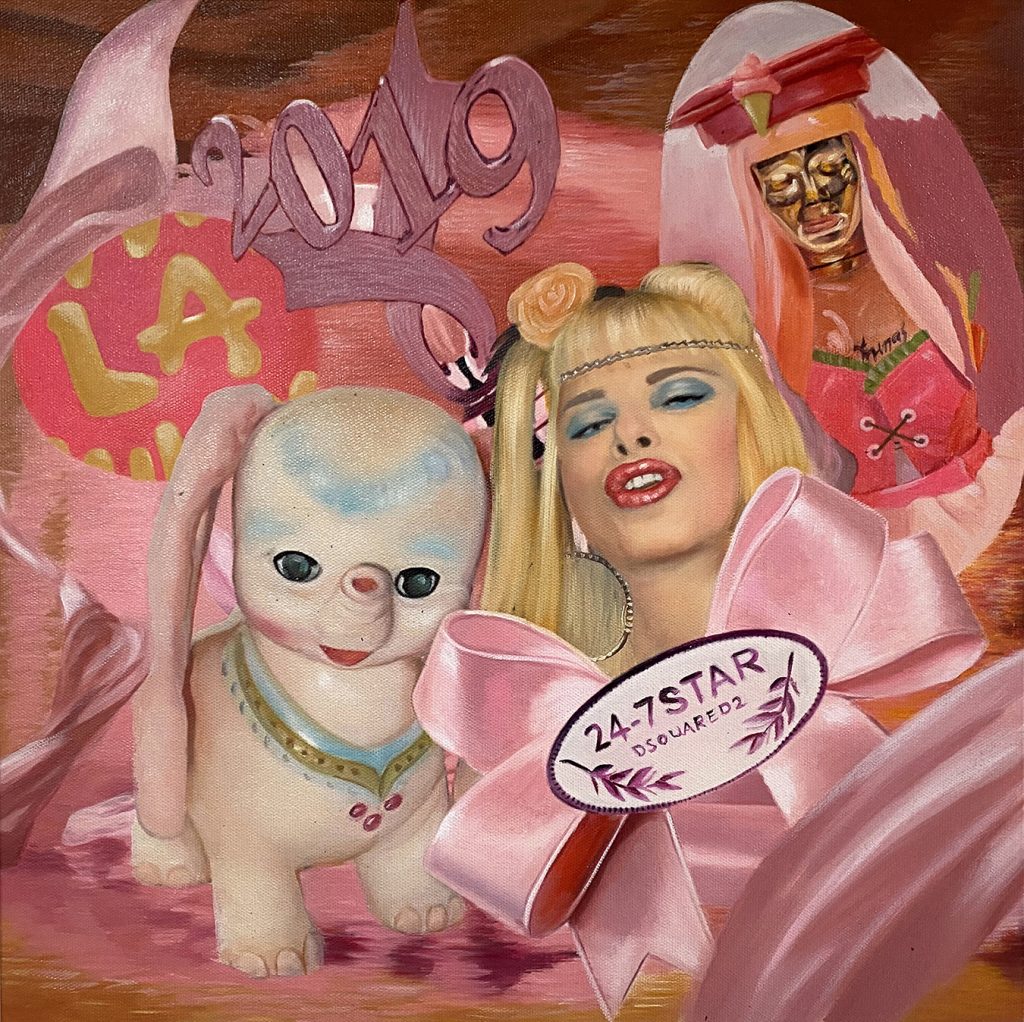
Alpha/Omega (LAX), 2020
35.1cm high x 50cm wide
Oil & Acrylic on canvas (stretched)
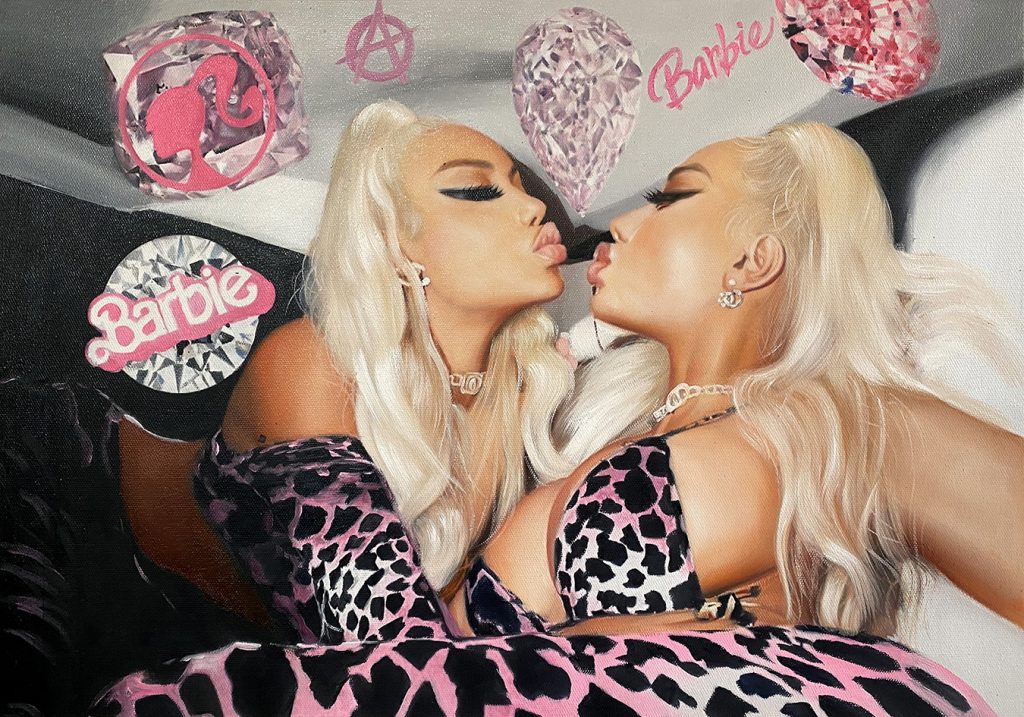
Barbie Twins (2 Hearts), 2020
42.5 cm high x 60.5 cm wide
Oil painting on canvas (stretched)
Victoria Todorov & Ainslie Templeton
Ainslie: To speak of high and low culture meeting in an era where the biotechnologization of the body and efflorescence of microscale mediatised cults-of-personality have become de rigueur is to enter the territory of post-cliche: Victoria Todorov prefers using and abusing when it comes to her stunning interventions into the language of contemporary art. It has been a thrill to see her photorealistic paintings circulating in this year of years, and to see them featured recently at Suite 7a, where I am told there are more coming. Below we discuss the works, and the narratives of beauty, loss and wellness that informs them. What are the works that you have given Suite 7a?
Victoria: I have given Suite 7a a series influenced by the online communities of bimbofication, pro-plastic aesthetics and an admiration for the process of transformation to express oneself. A few of the works feature Lolo Ferrari, a French erotic actress and cultural icon starring in the Television series Eurotrash. Lolo was a complex and divisive beauty, who had a dark reality and suspicious death. I am personally mourning loved ones this past 2 years so I wanted to do some celebration of life with underpinnings of struggle and vulnerability.Ainslie: I'm sorry for your losses darling. If the paintings are in part a response to mourning and a celebration of life, they are extremely gorgeous and provocative (the many faces of hot pink) at the same time. In Wonder of Scam, the splodges and brush strokes are presented like in a makeup estore, while the shifty main subject gives a feeling of exploiting / being exploited that feels very knowing and sexy to me. That's not Lolo is it?
Victoria: Thank you love and it is exciting for me to hear your interpretation! I have been looking at a lot of makeup textures and layering lately. The lady in the picture is Angelyne, Angelyne is an American singer, actress, personality and model who came to prominence in 1984 after the appearance of a series of iconic billboards in and around Los Angeles, California which read only & and pictured her posing suggestively. - Wikipedia. I am always interested in the evolution of social media, the Myspace-era aesthetic influencing me a lot. So naturally I started to think about pre-Internet and Angelyne kind of was an influencer / presence via print media. I like the way she marketed herself mysteriously, behind a fan, and monetised any interaction. I love her personal style and use of colour, it has informed so much of the colour palette in works in development. I think they just made a TV show about her too which is nice!
Ainslie: How do you think you and your work would thrive better there versus here?
Victoria: I feel I would be safer, happier and enriched in the US. A lot of what I consume is American, the people I am friends with online are from there. I feel so much potential in the Big Apple, it is hard to describe what I think the US represents but I just really adore it. There is more diversity in general - it's not perfect I am sure. I am wanting my Carrie Bradshaw moment like anyone. The people in the US also understand me better. In Melbourne I am relegated and they are only interested in ticking boxes or some unrelated agenda which gets gold stars for them perhaps lol. But in saying that, I have some other artists and wonderful people who genuinely support me, often not in the system if that makes sense?
Ainslie: I love cutting observations of desperate Melbourne people - it's hard to know where different systems begin and end, if that makes sense. We haven't ever met irl Victoria, but over the last few years I feel like I keep encountering total acolytes of yours. This year especially, it feels like your work is getting the wider traction and excitement that it commands. What's shifted for you in 2020, if anything?
Victoria: That is real sweet and it is sometimes you just connect in this effortless way, it is so nice. Melbourne can be insular, cruel, tall poppy, edge but on the flip it can be standard, accessible, surface, basic. I sit outside of it all and am too Paranoid / anxious to engage traditionally with it. That is why I am grateful to Suite 7a for letting me energetically be in beautiful Sydney, I am into the idea of living a Sydney lifestyle. I think: Vitamin D, vitality, love, good taste, juice, polished and glam. I am not sure what has changed this year, perhaps being more vulnerable made some people interested, or something in the work resonated more. On a personal level, it has been a spiritually exhausting year for me, but lined with hope. I am excited to be working with several people I respect and admire so much on upcoming projects.Interview
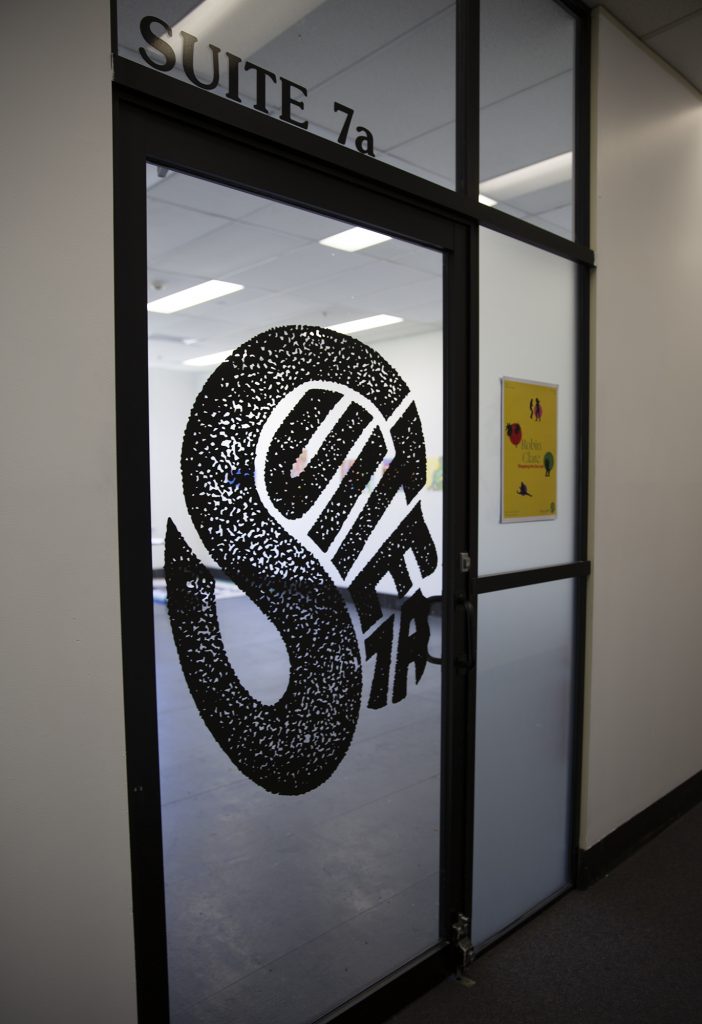
Documentation Suite 7a in the Hallway & Studio including Rozsa Erica, Marilyn Schneider, Xu Jing, Dylan Nicolas, Elise Petersen, Robin Clare, Rebecca Scibilia & Dylan Nicolas Suite 7a, Oxford St Darlinghurst
Archival shows
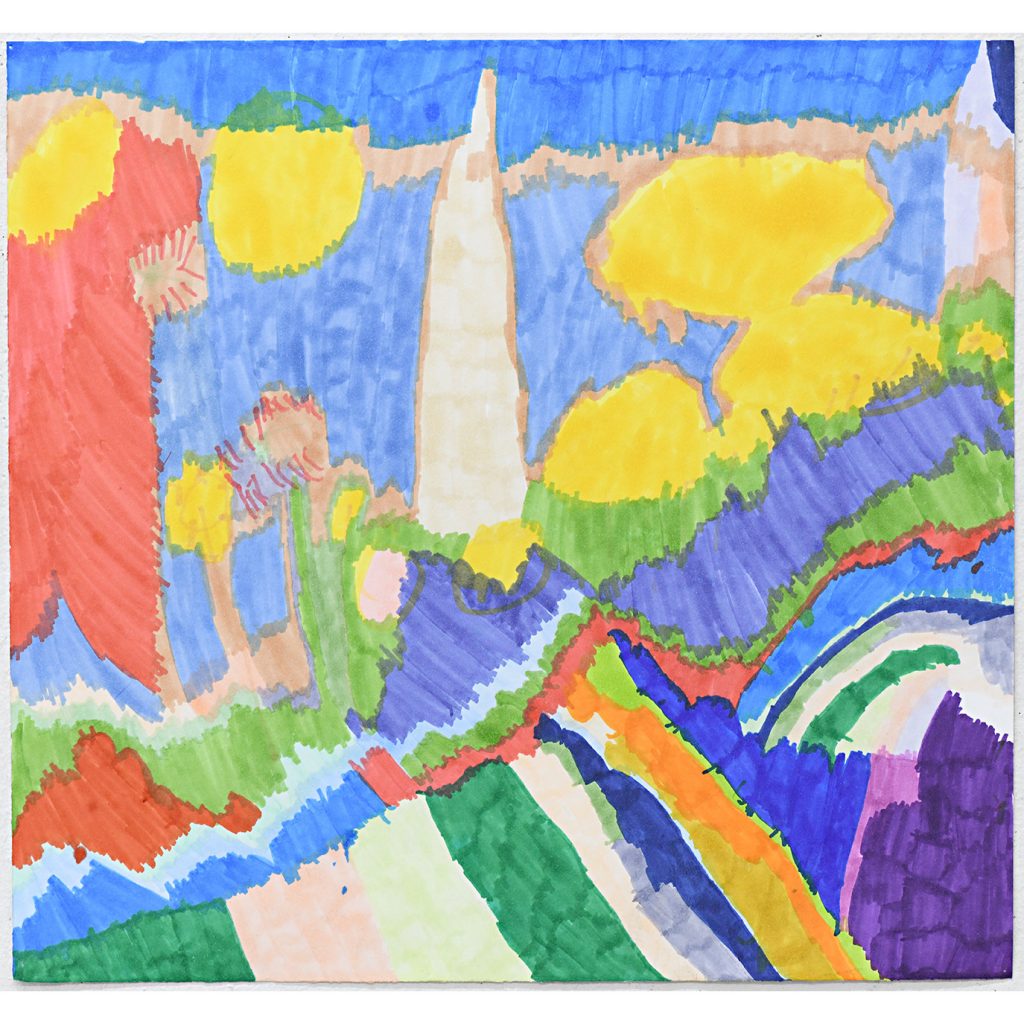
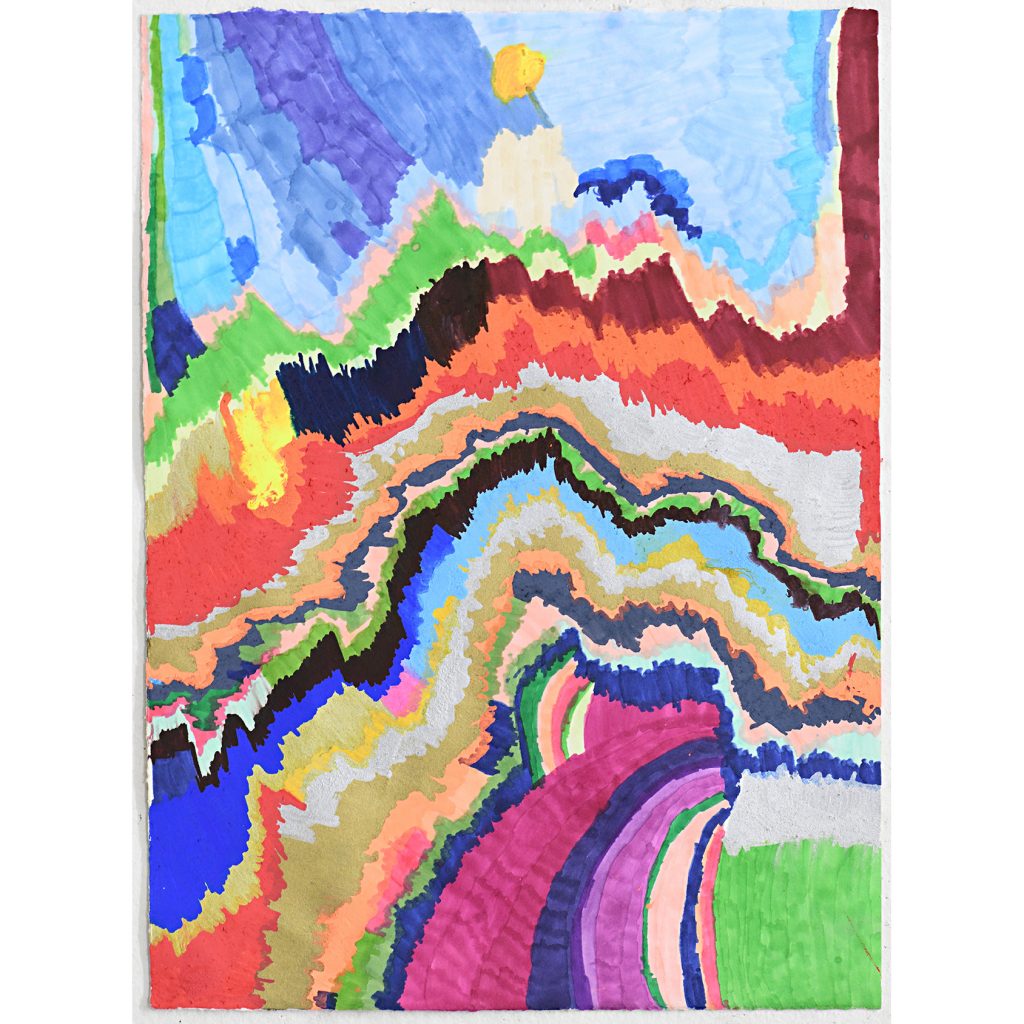
Rebecca Scibilia 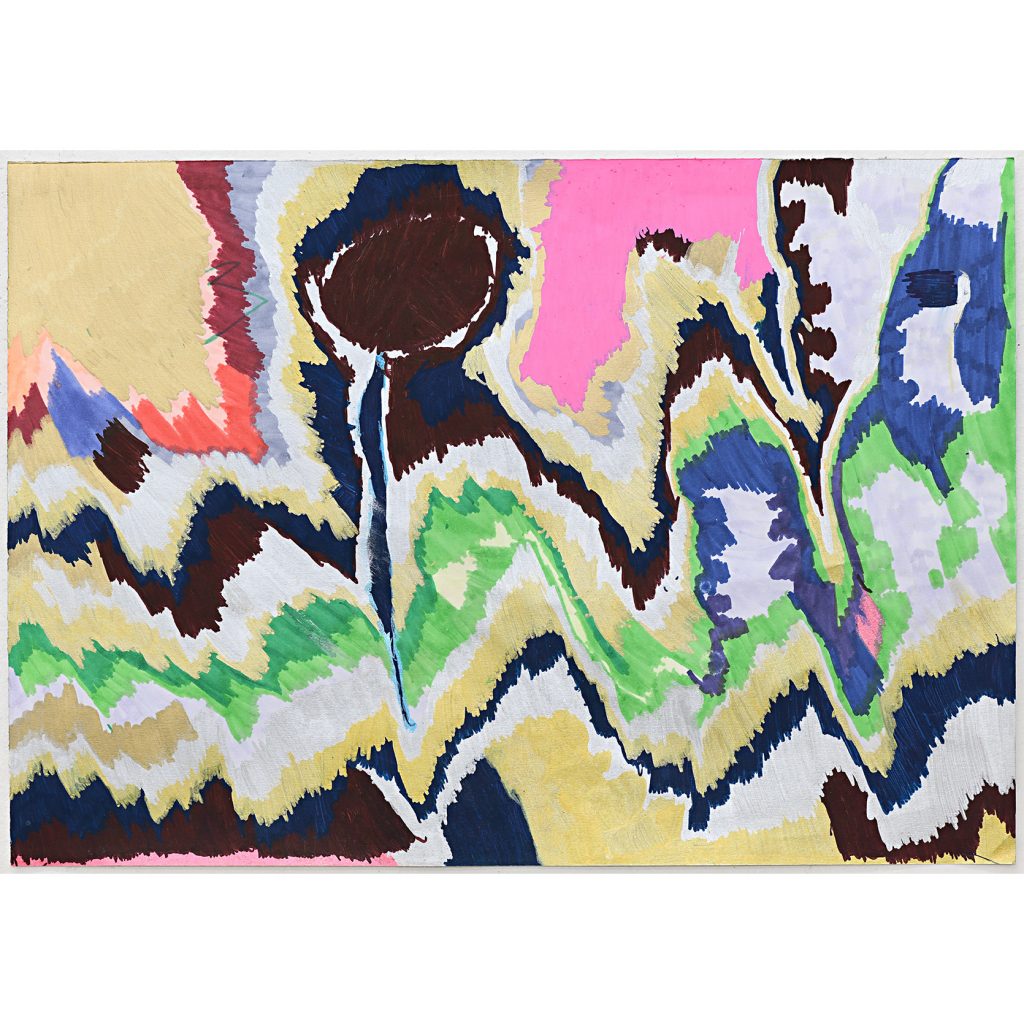
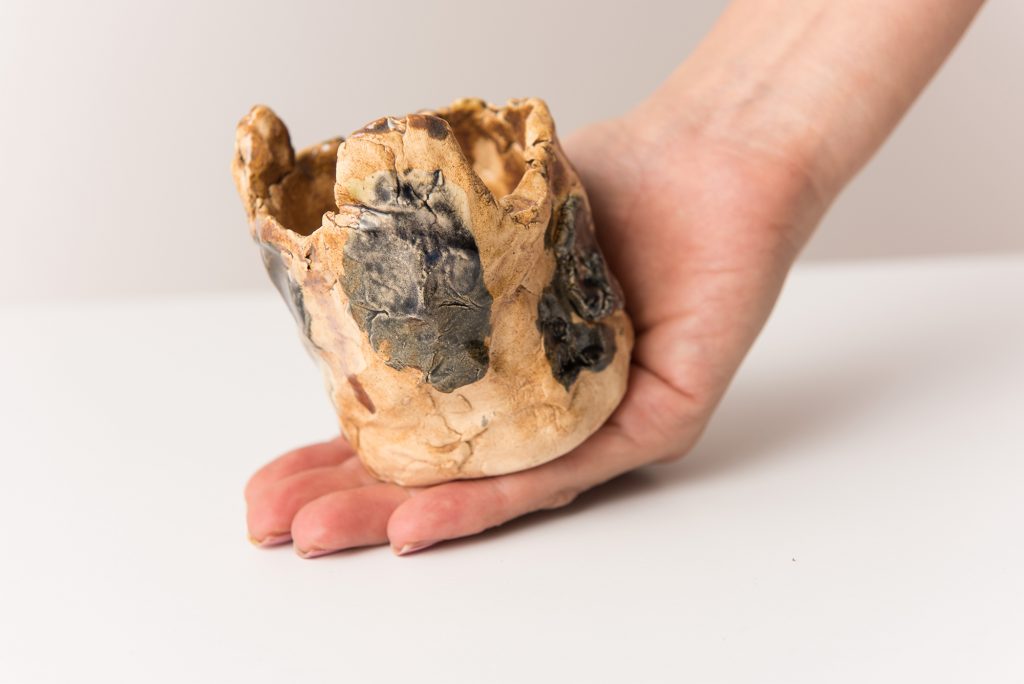
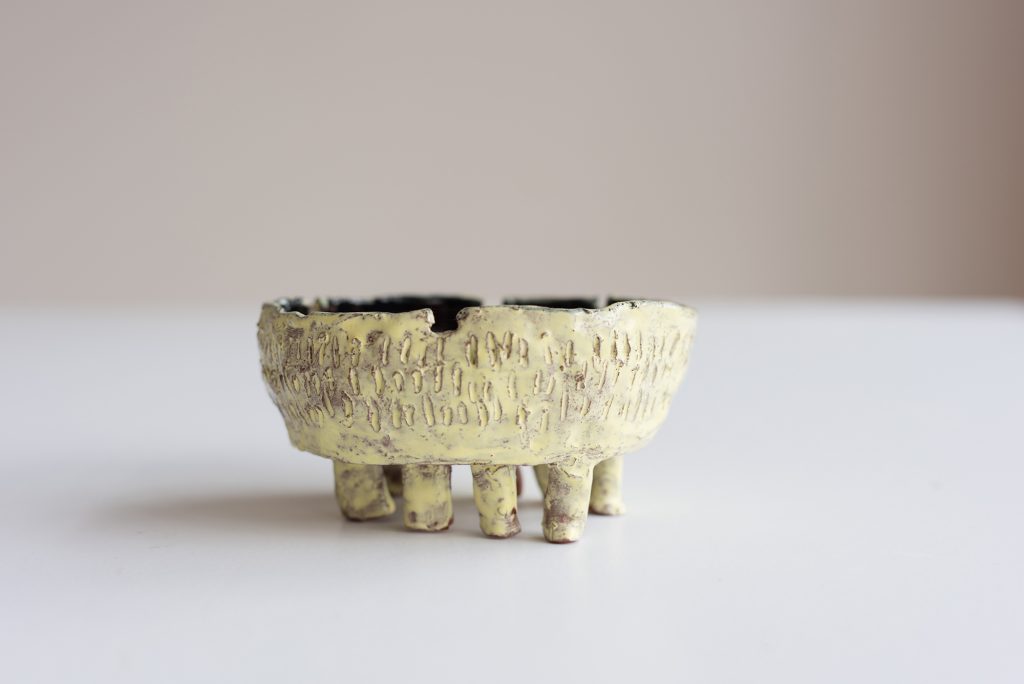
Kiki Ando 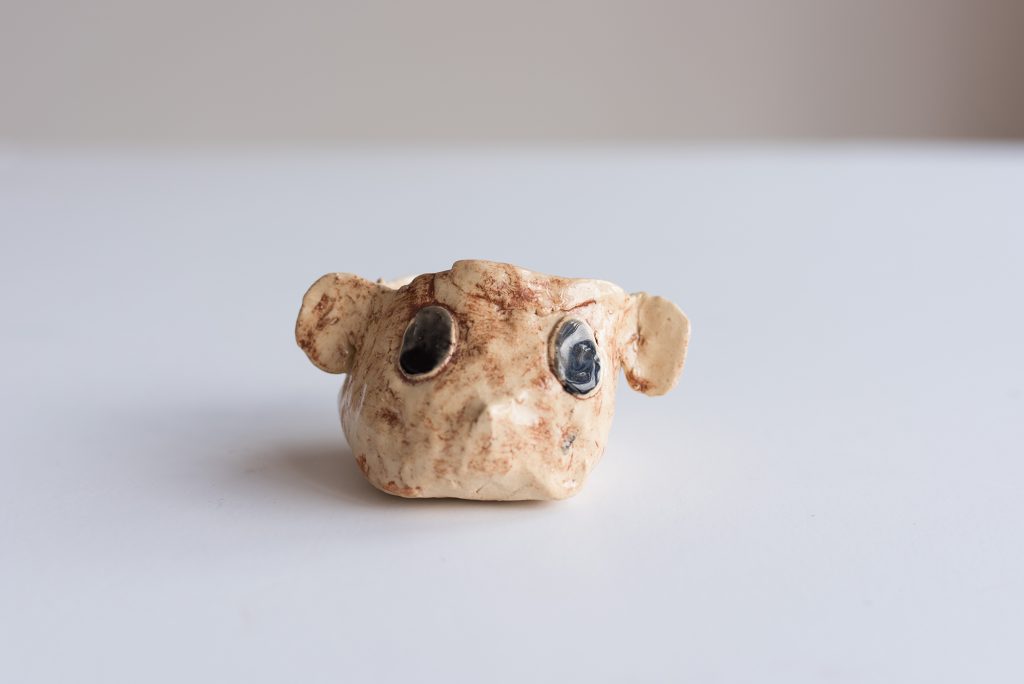
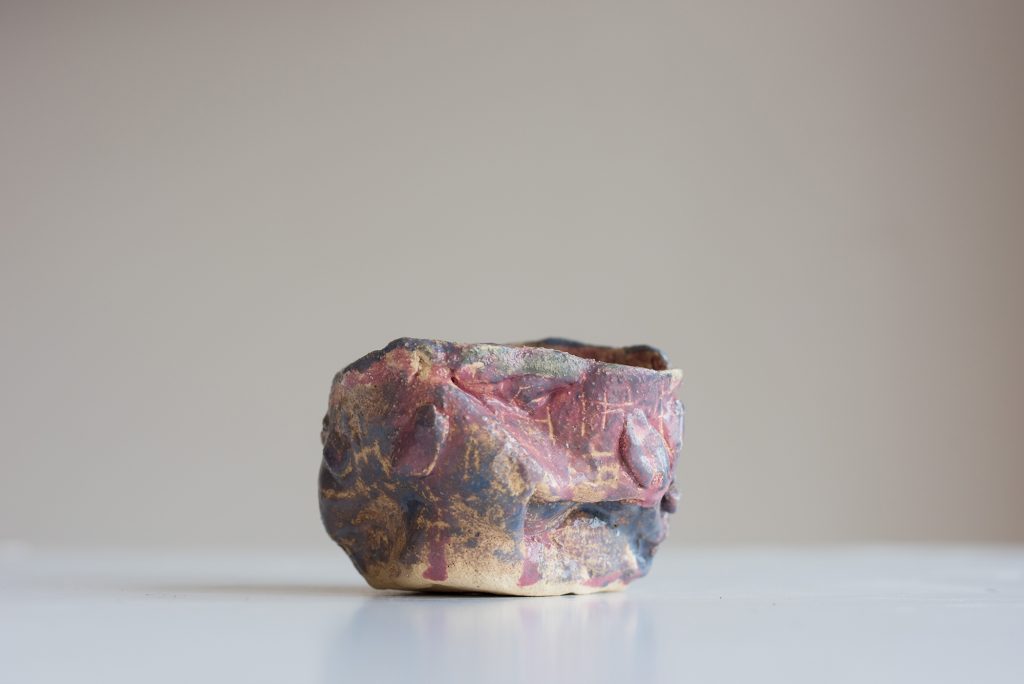
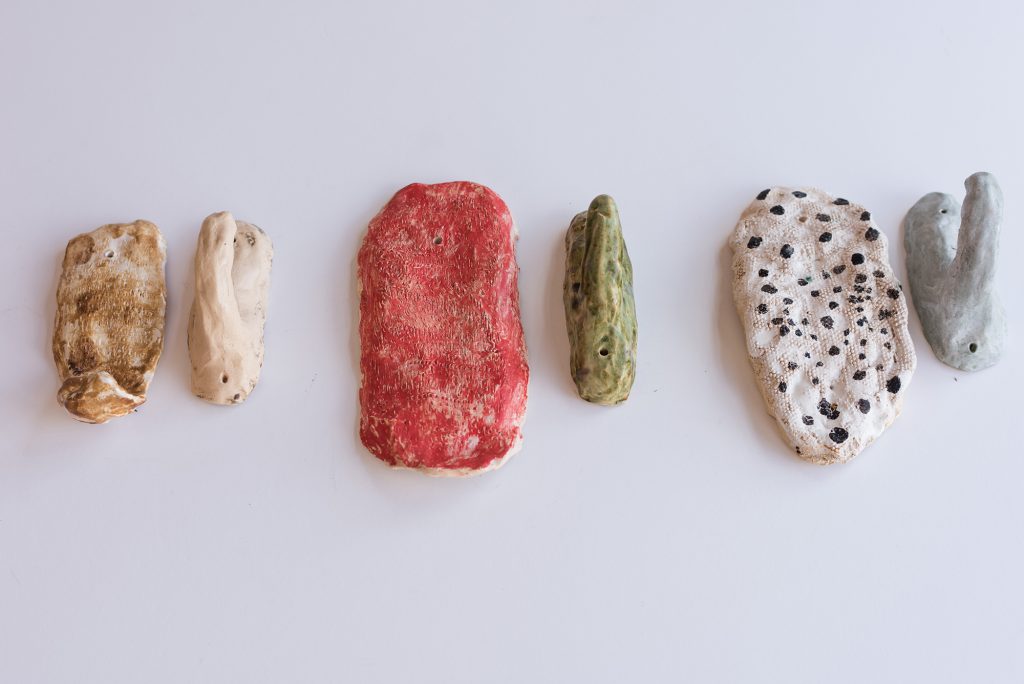
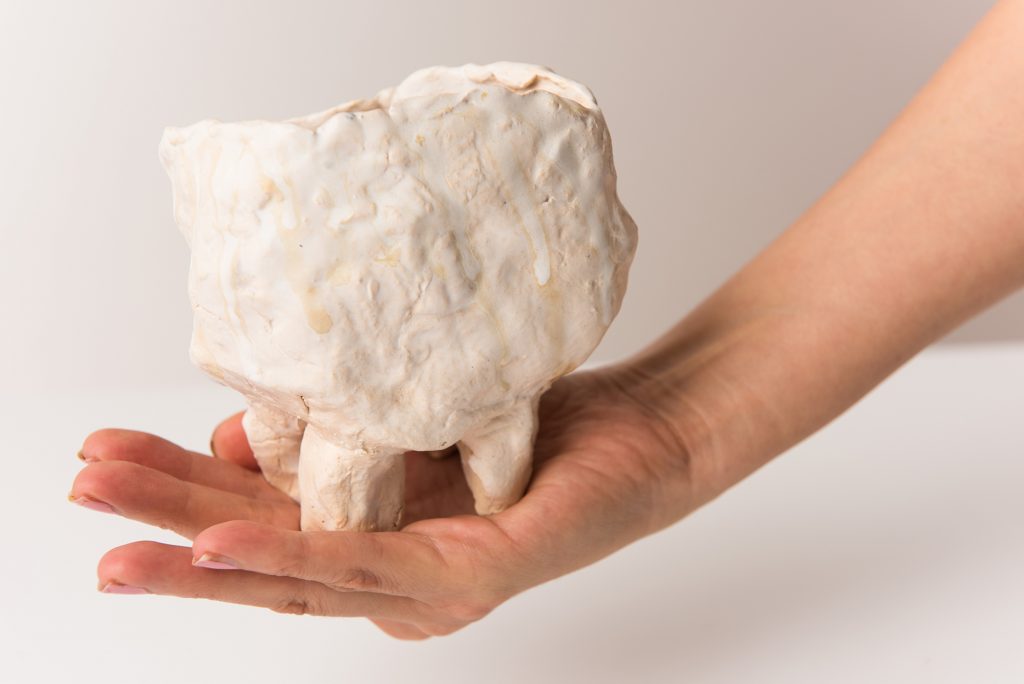
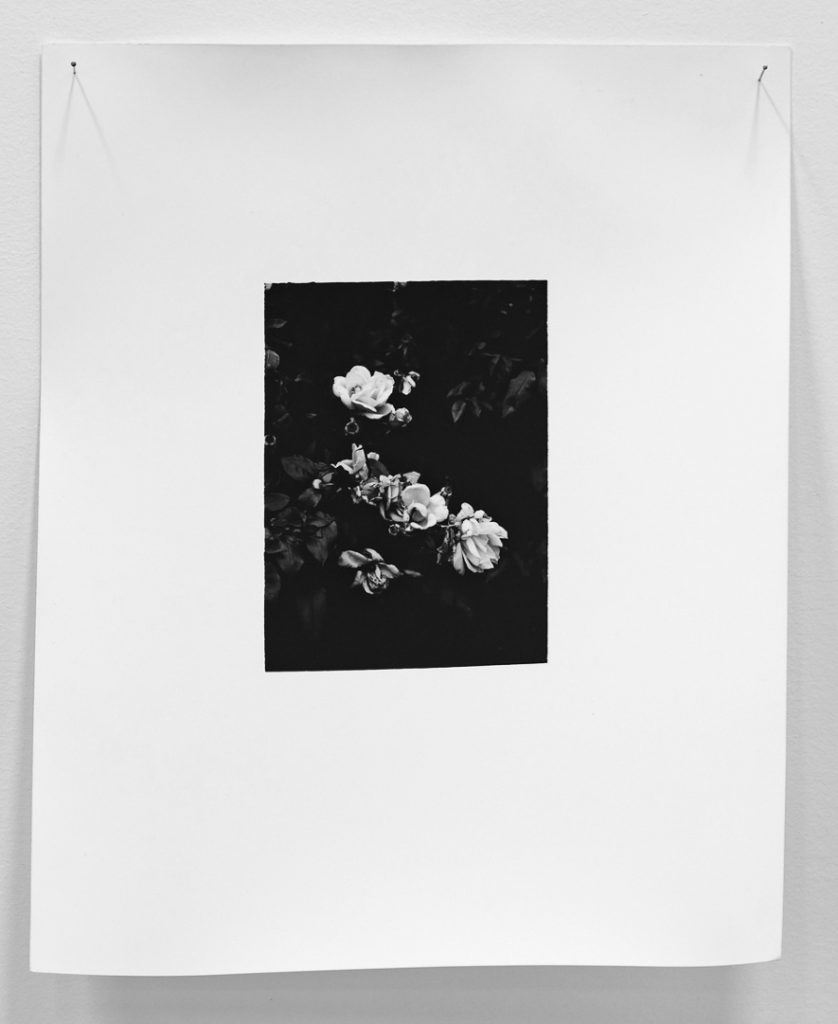
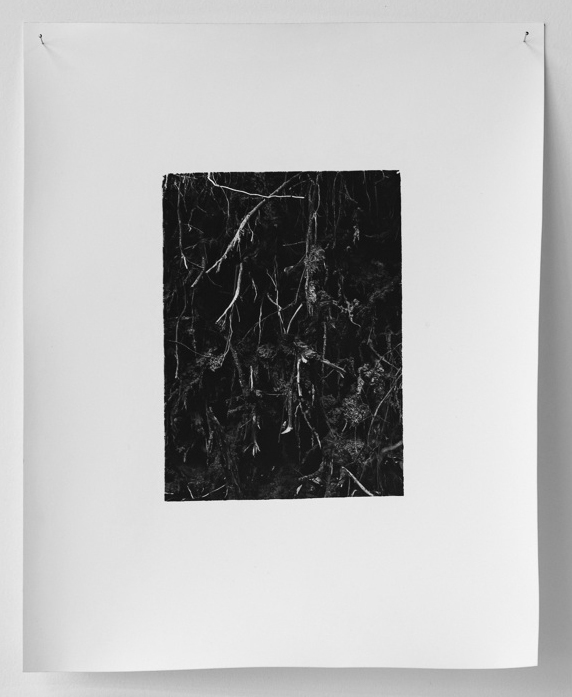
Saskia Pandji Sakti 